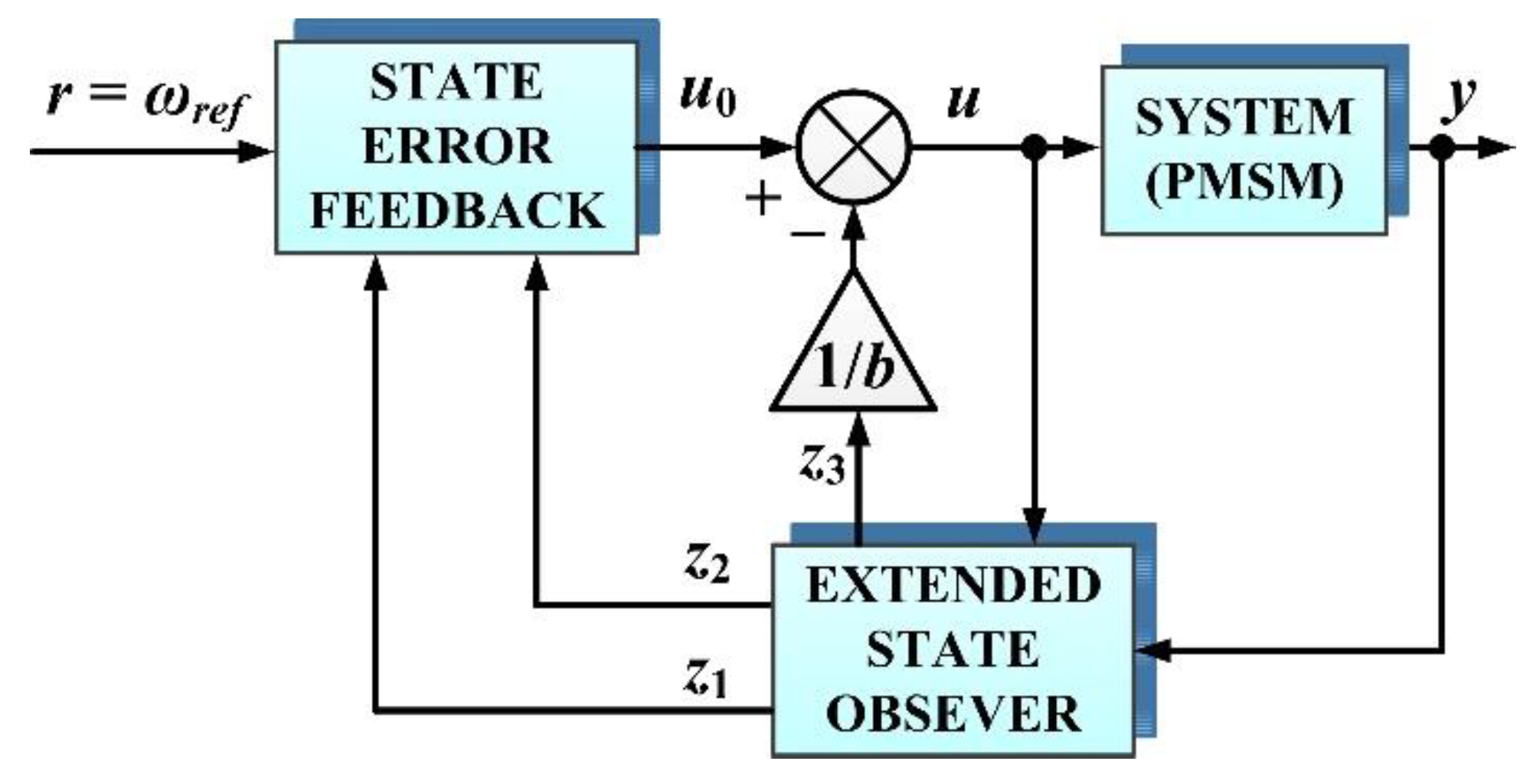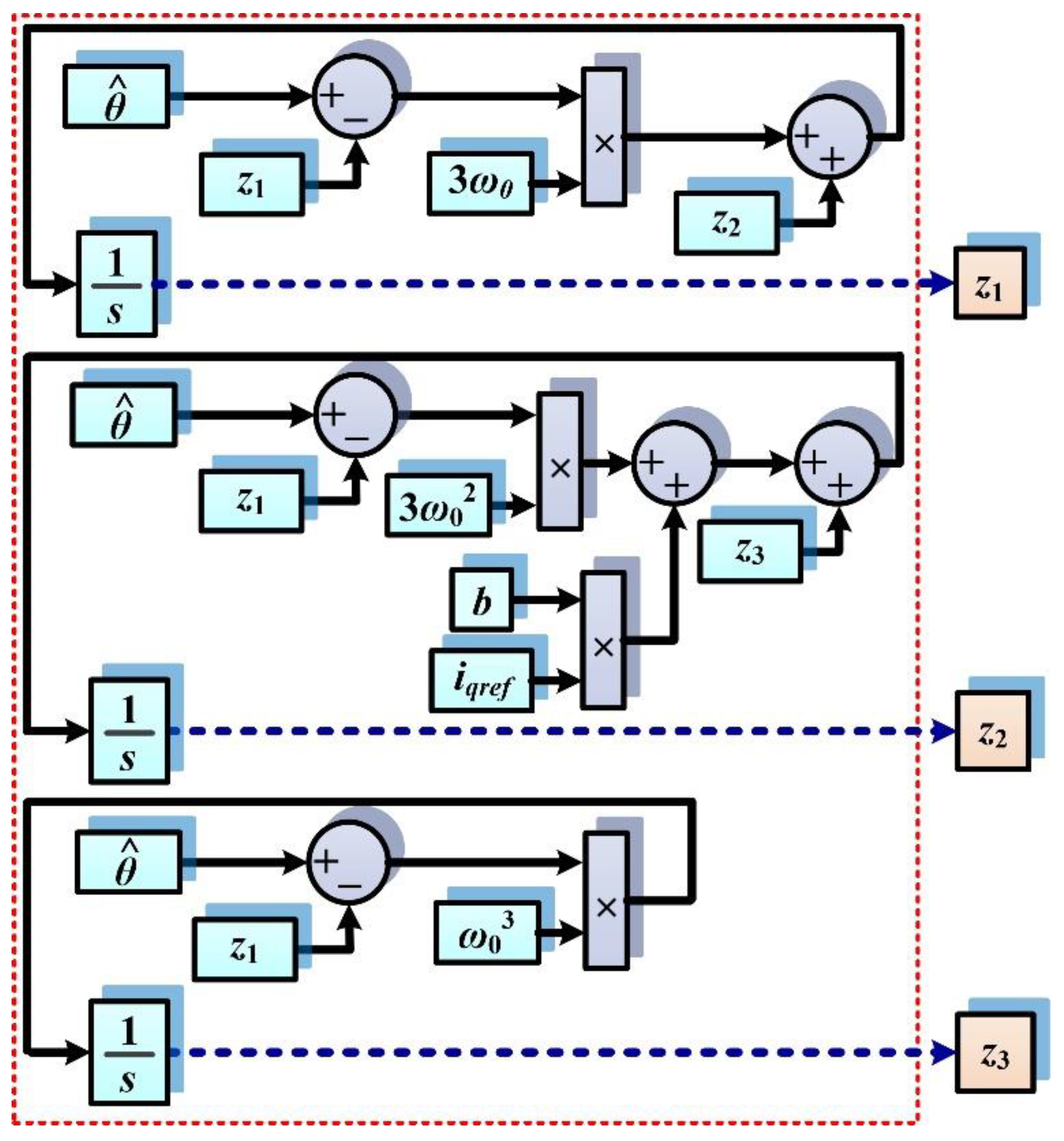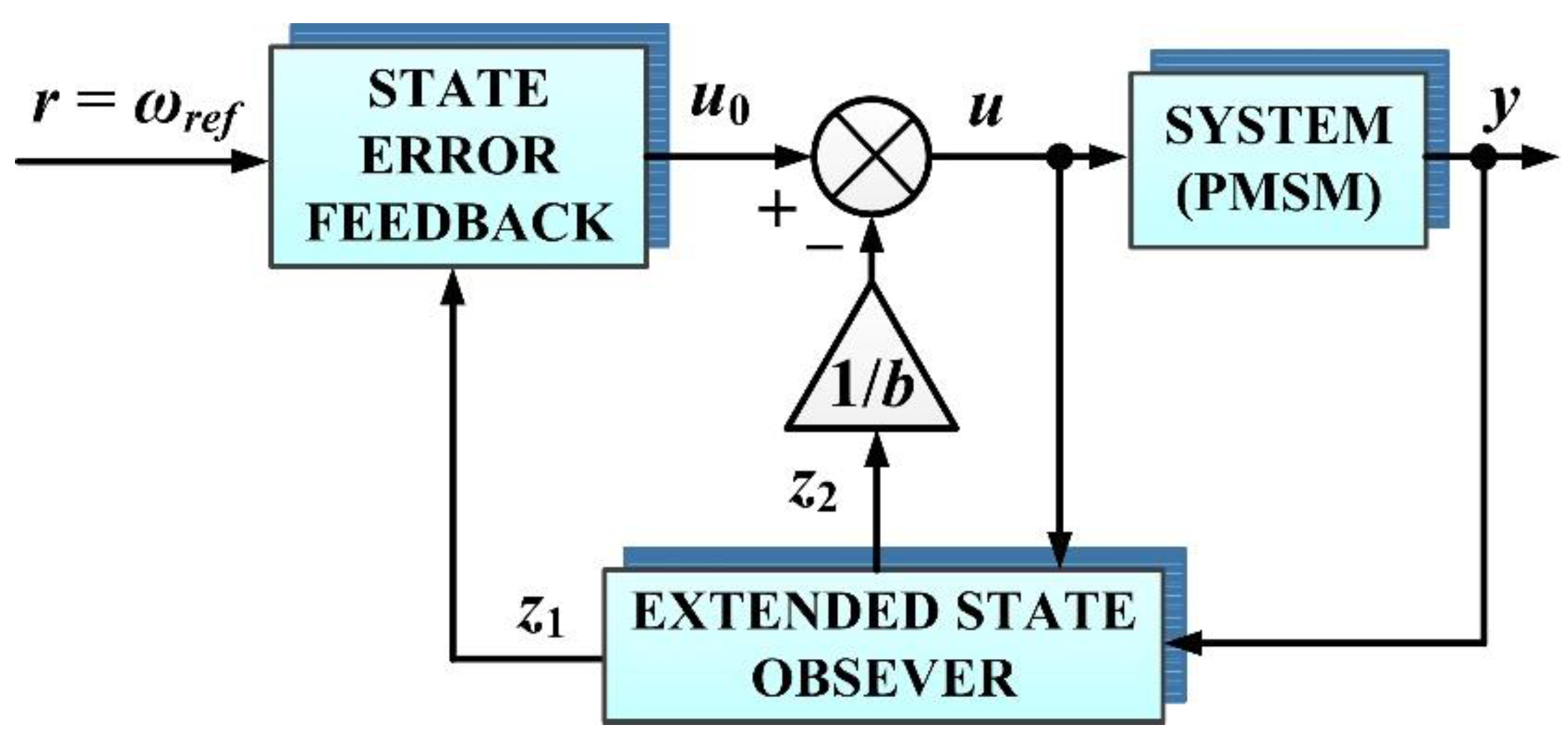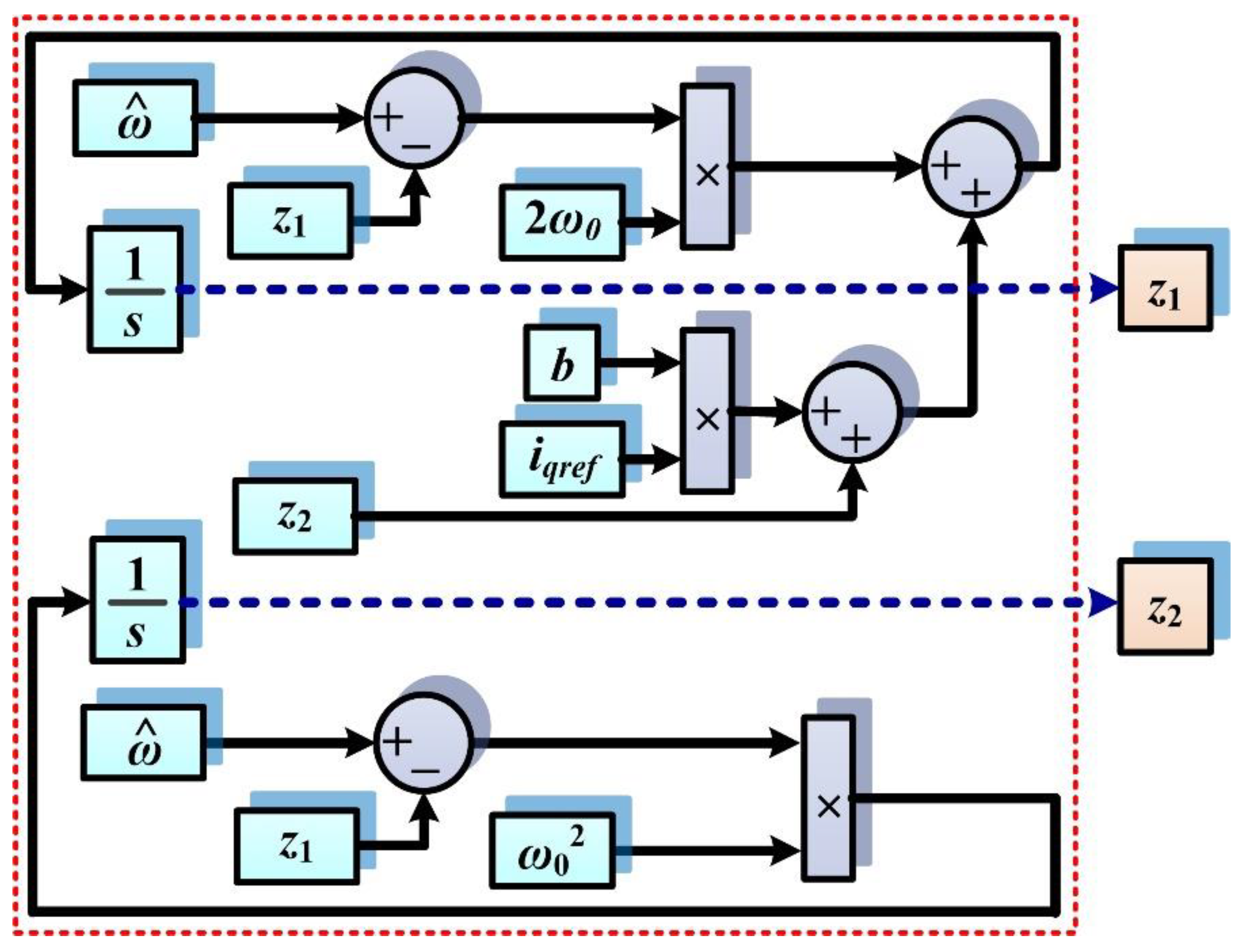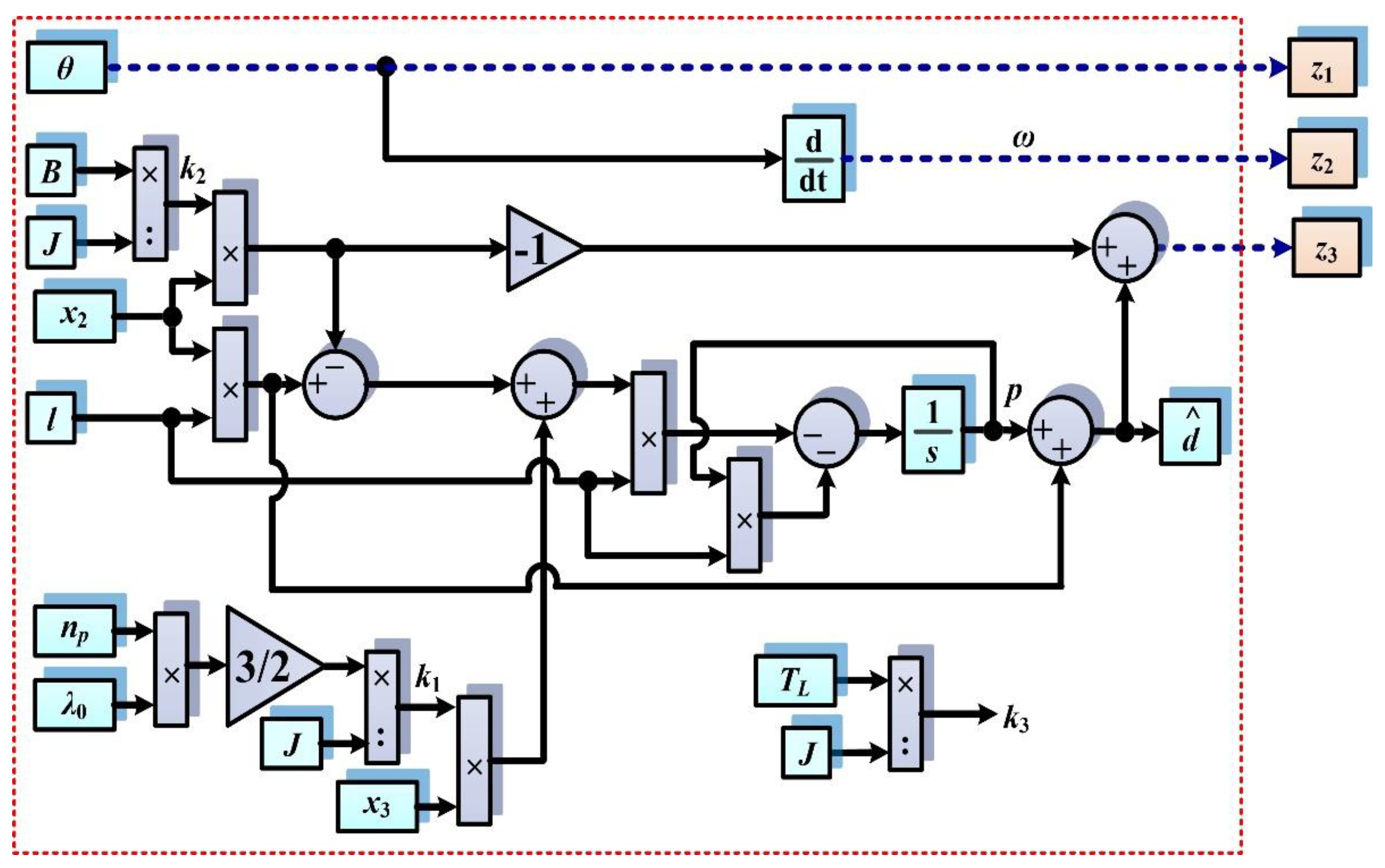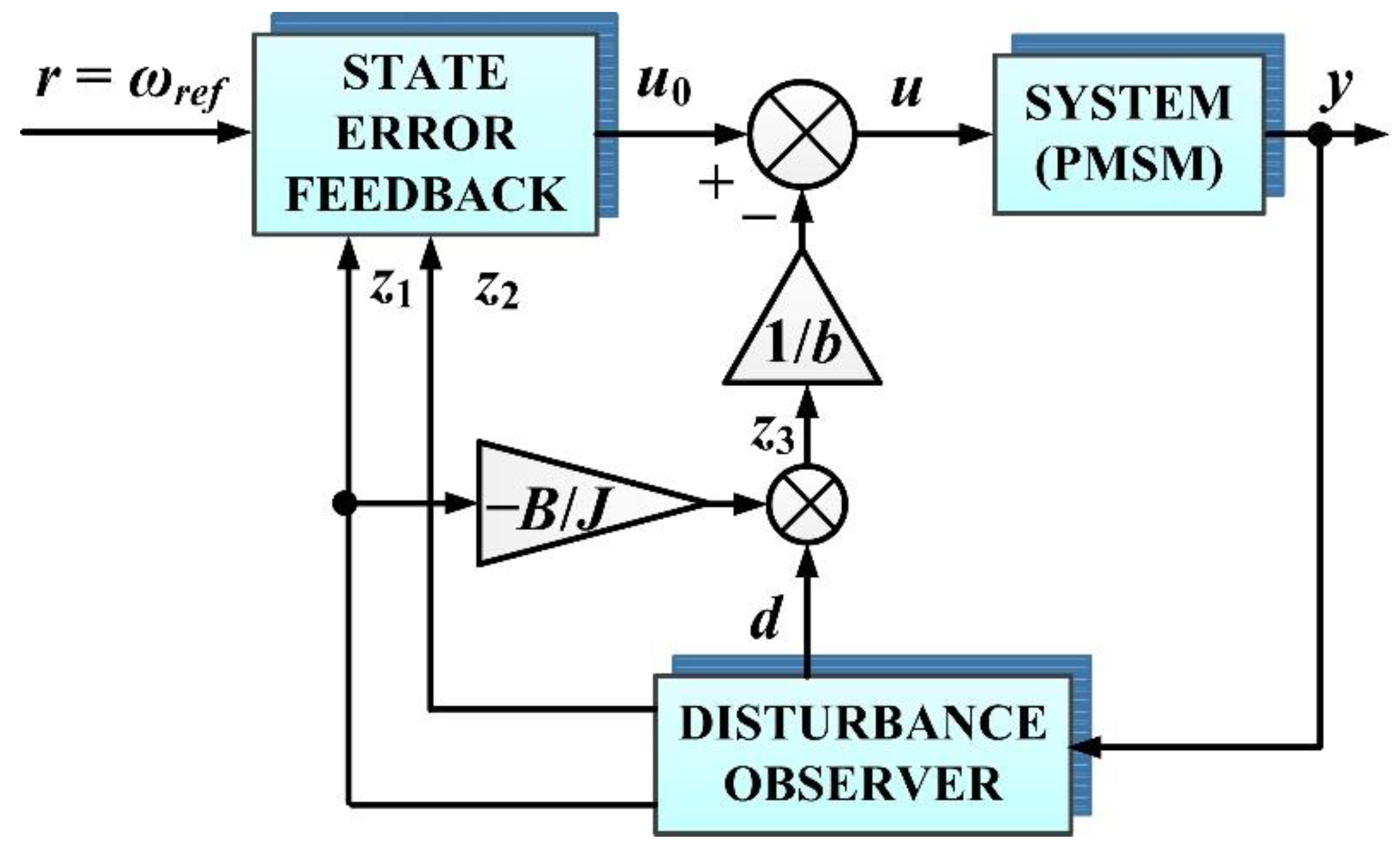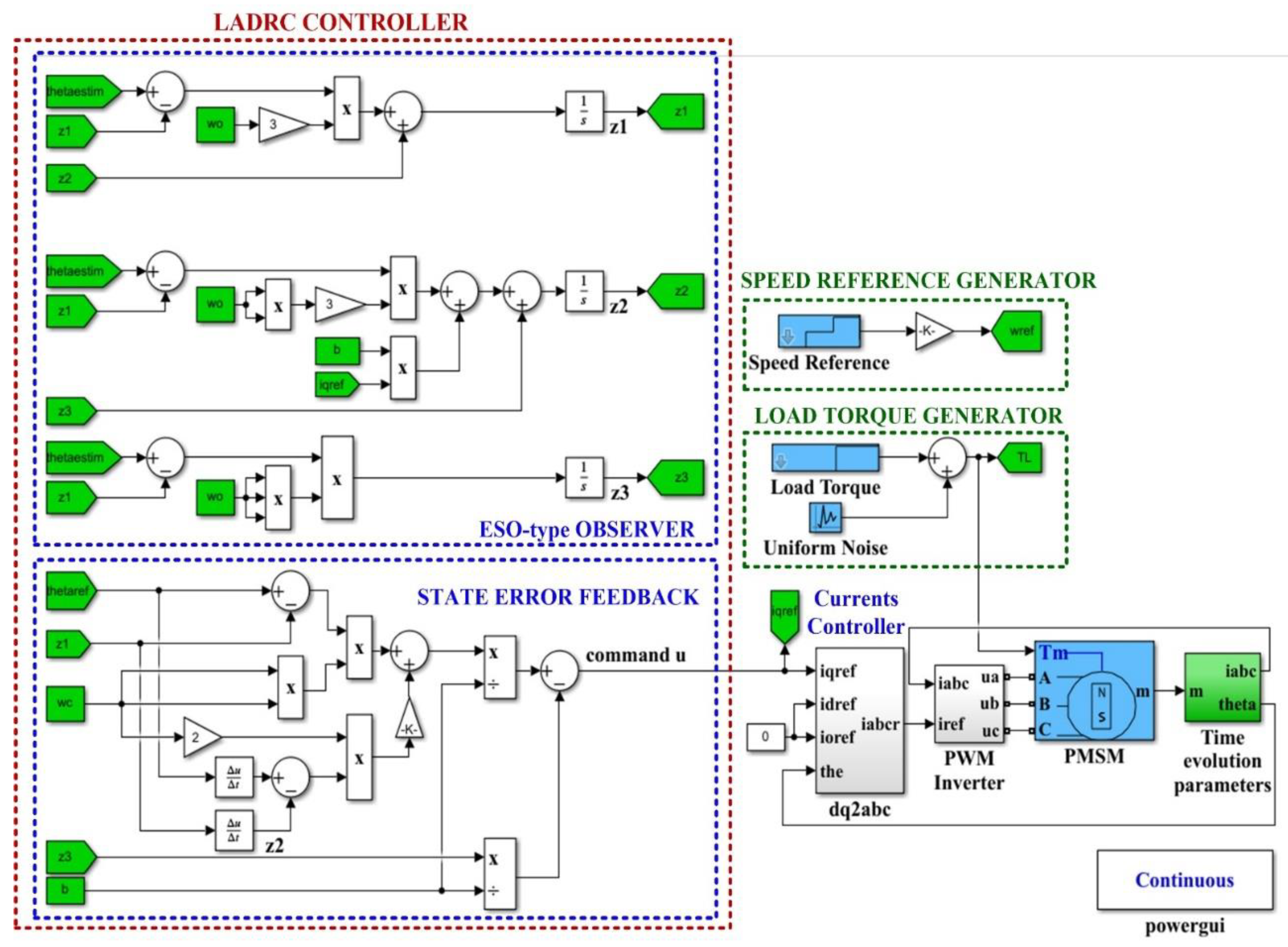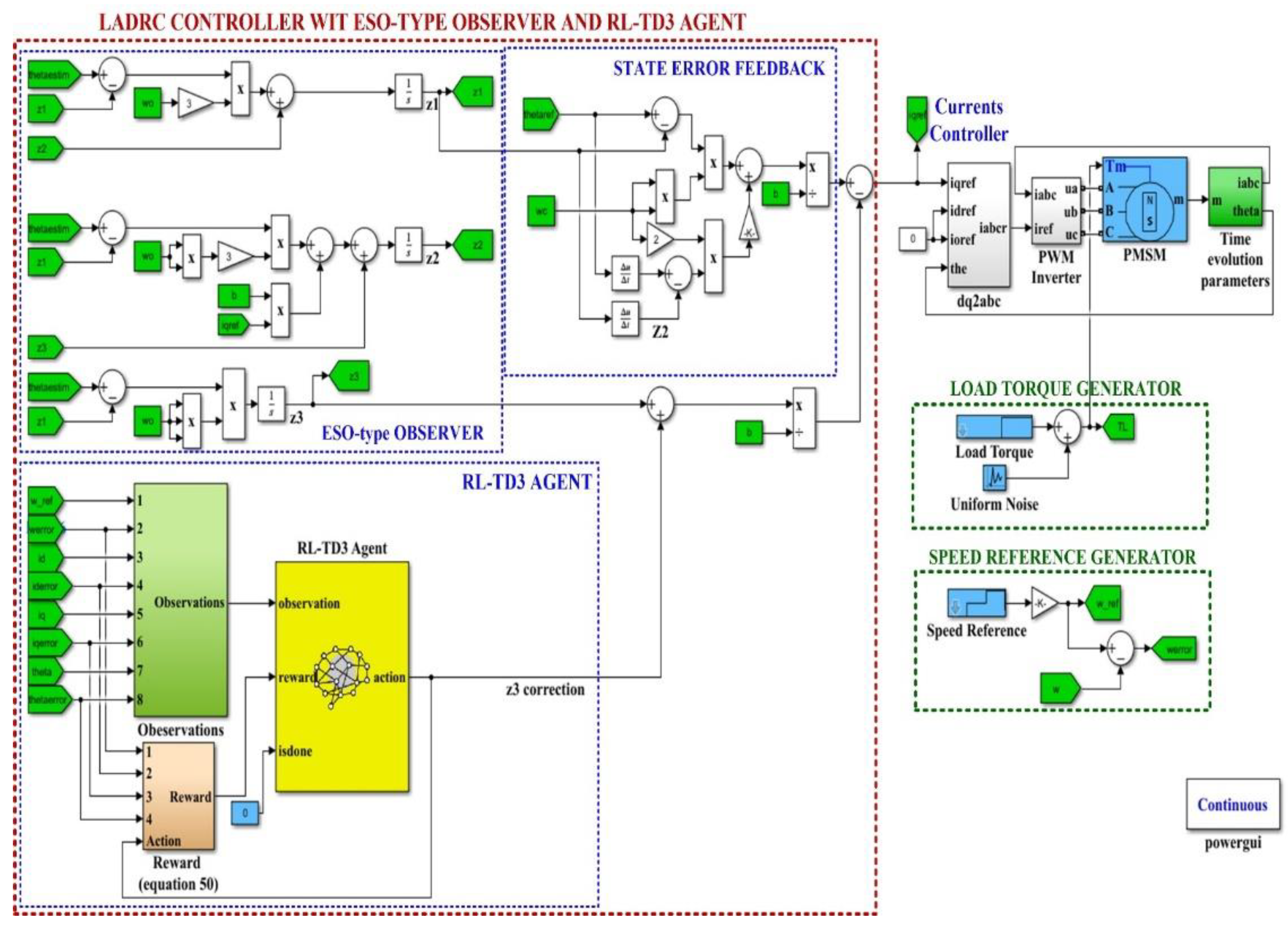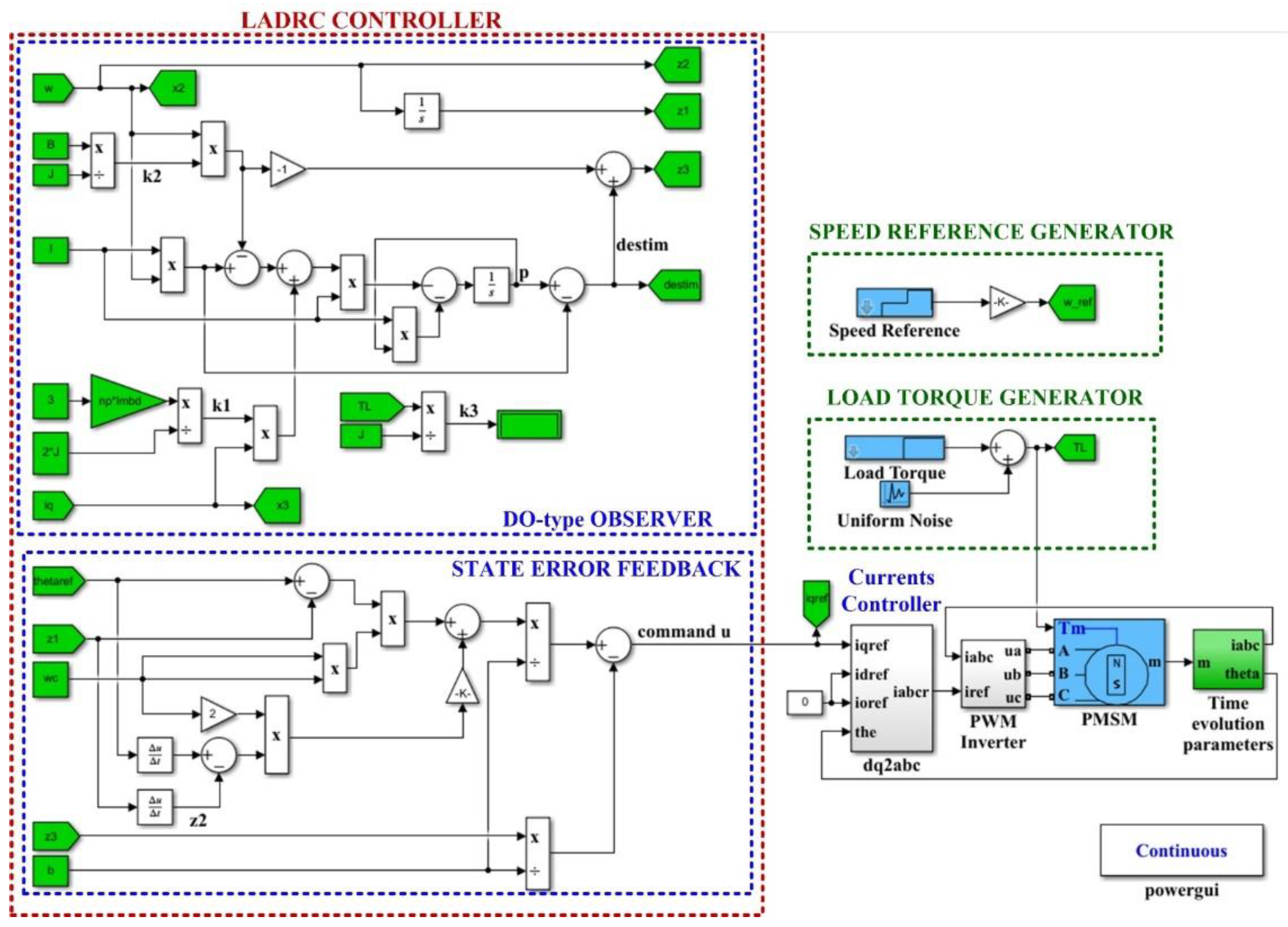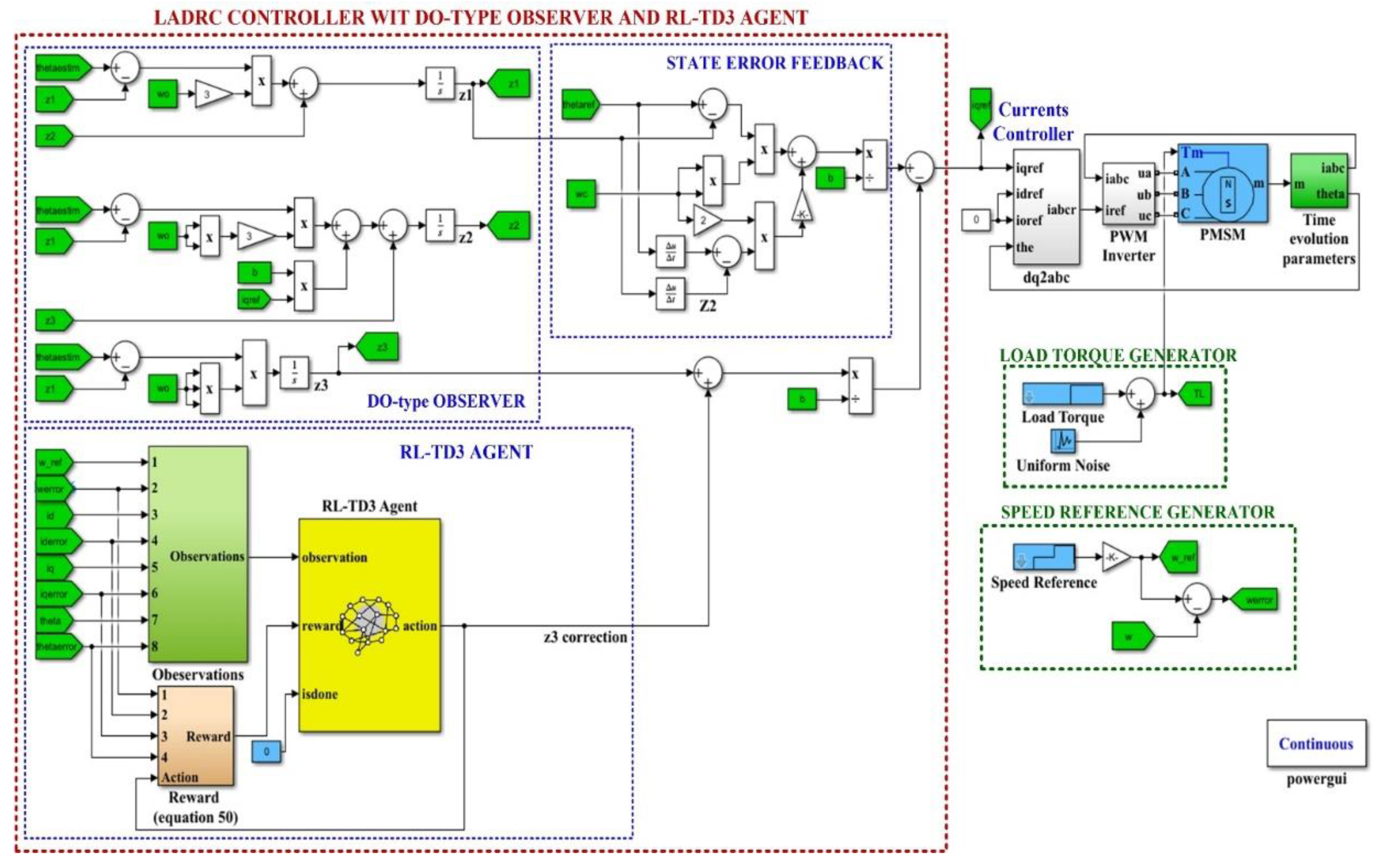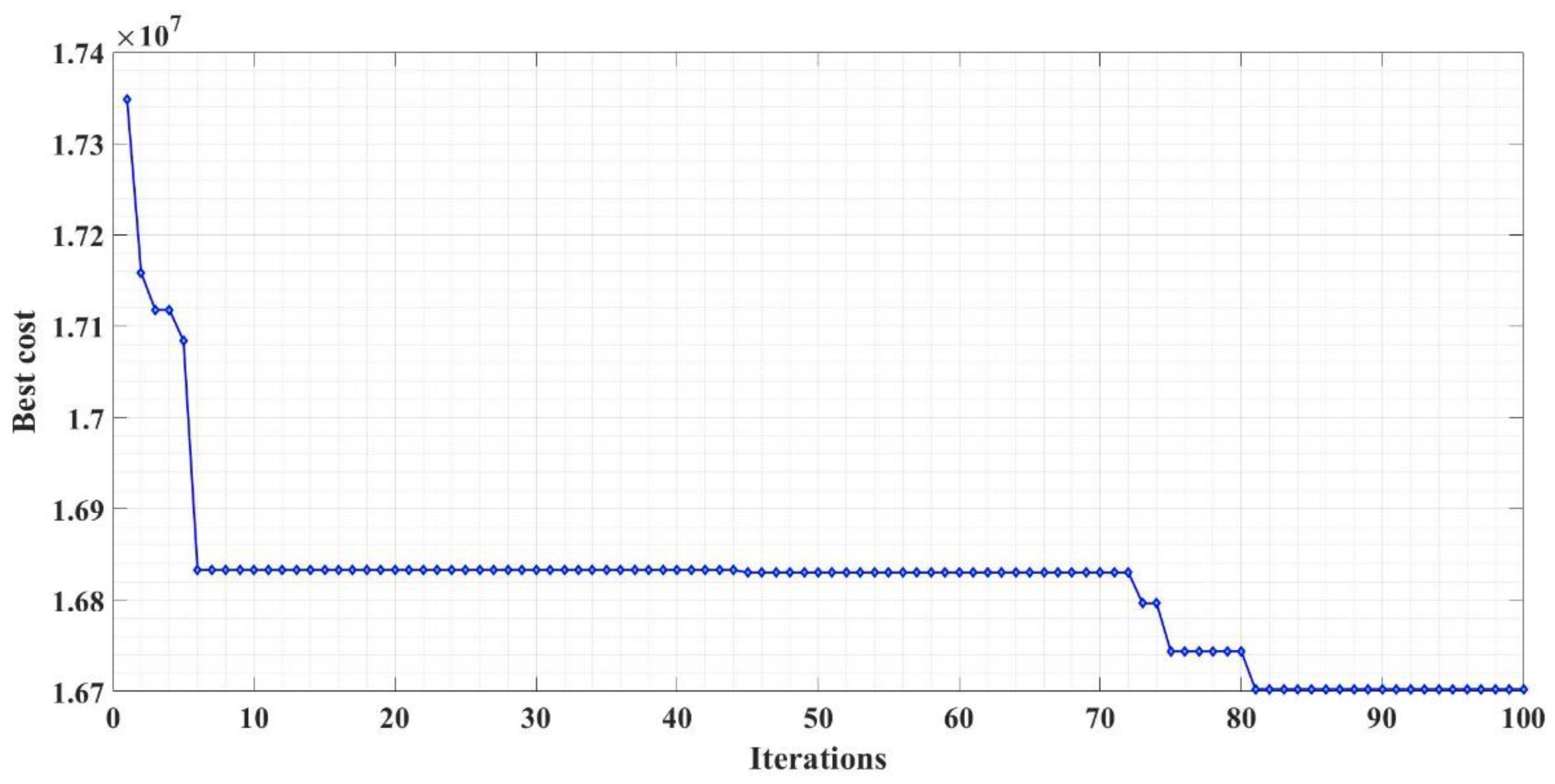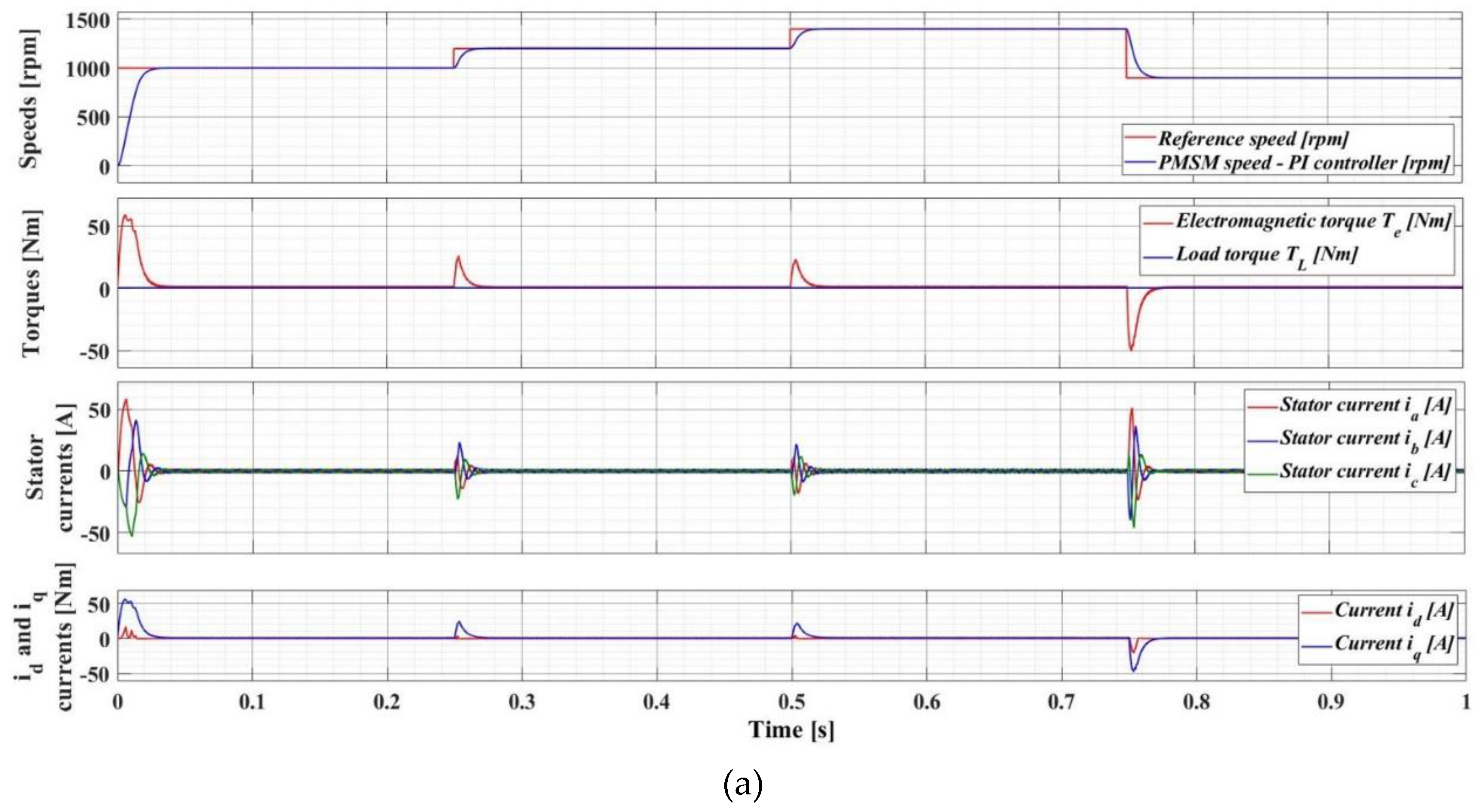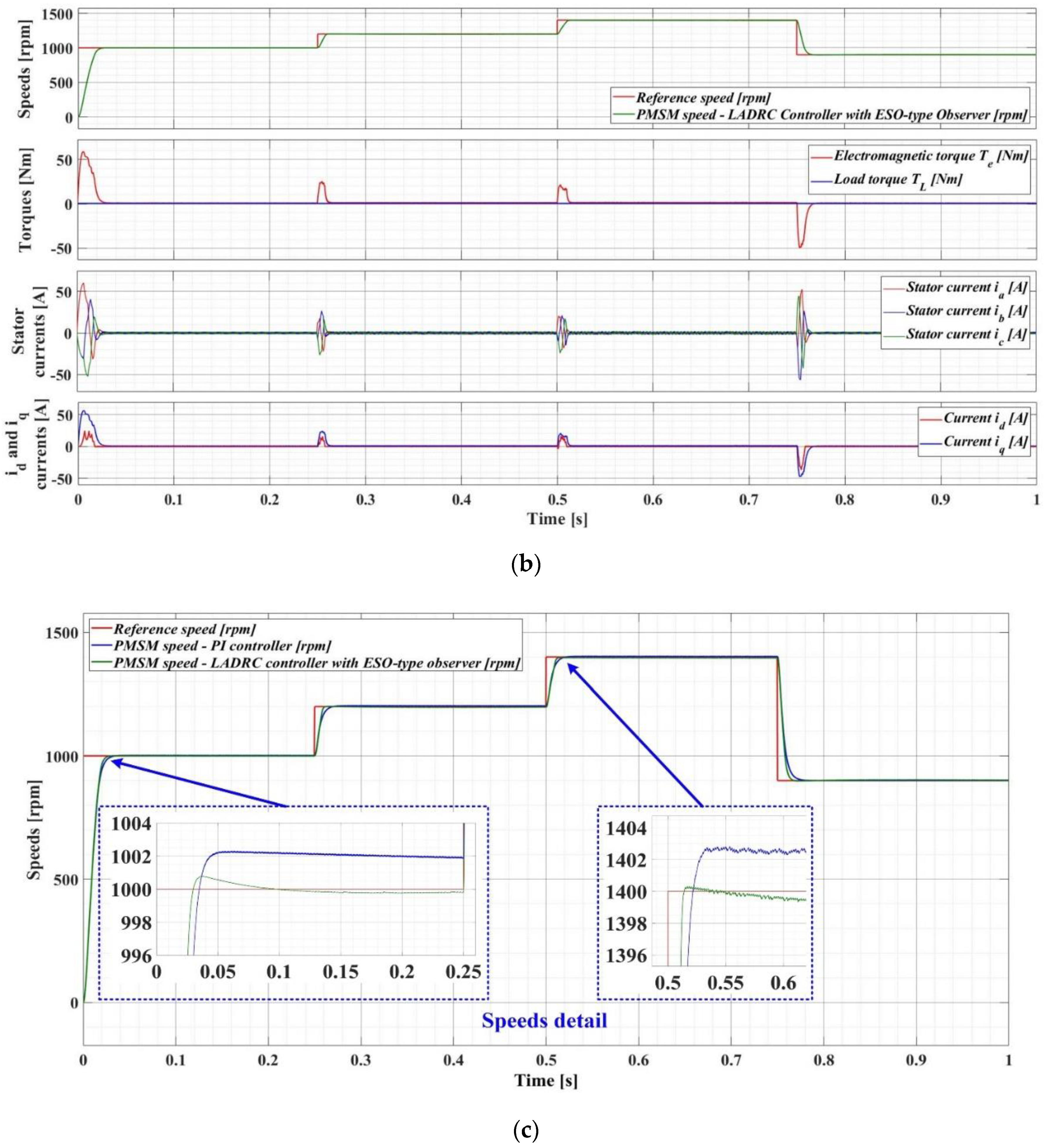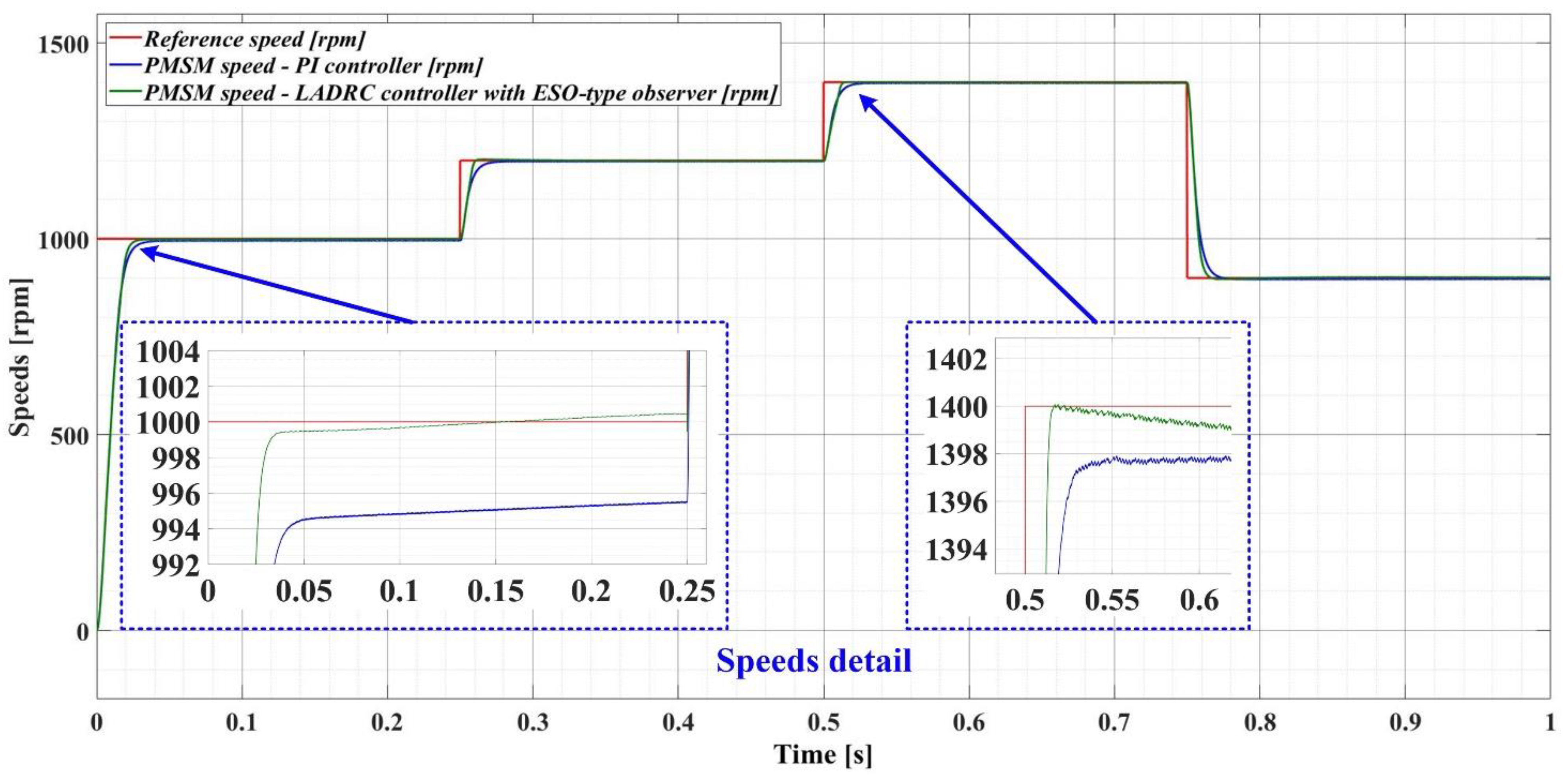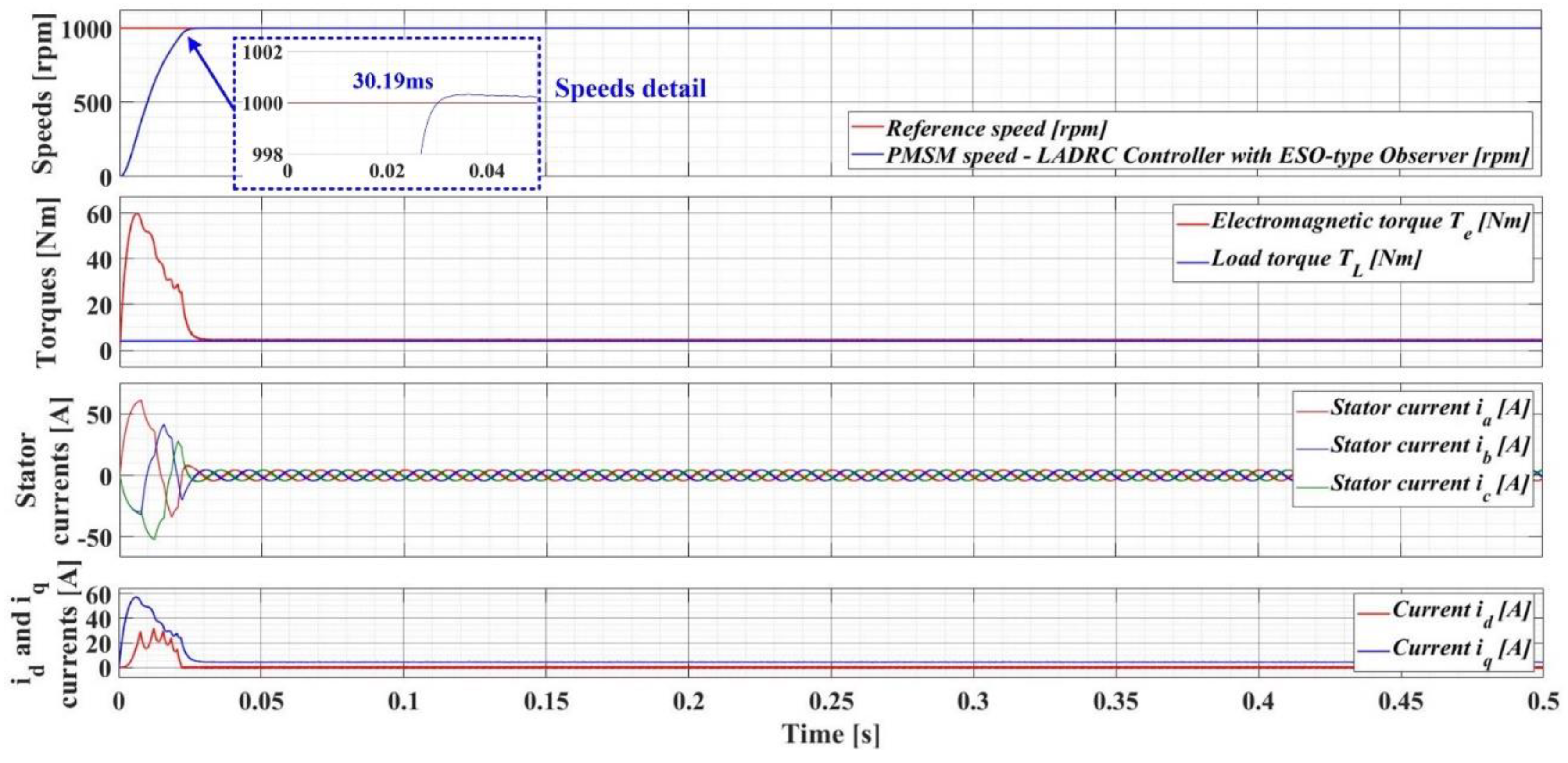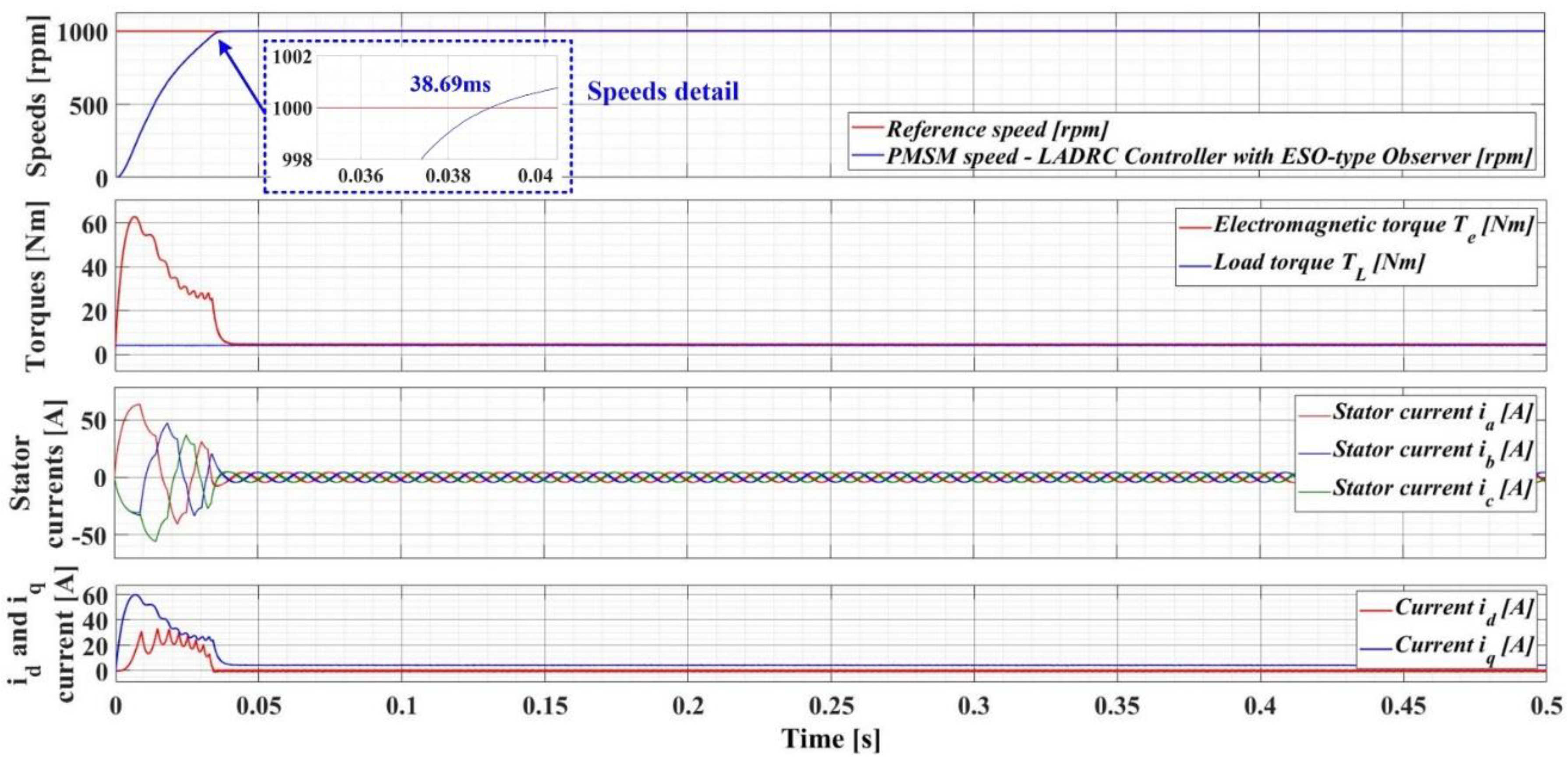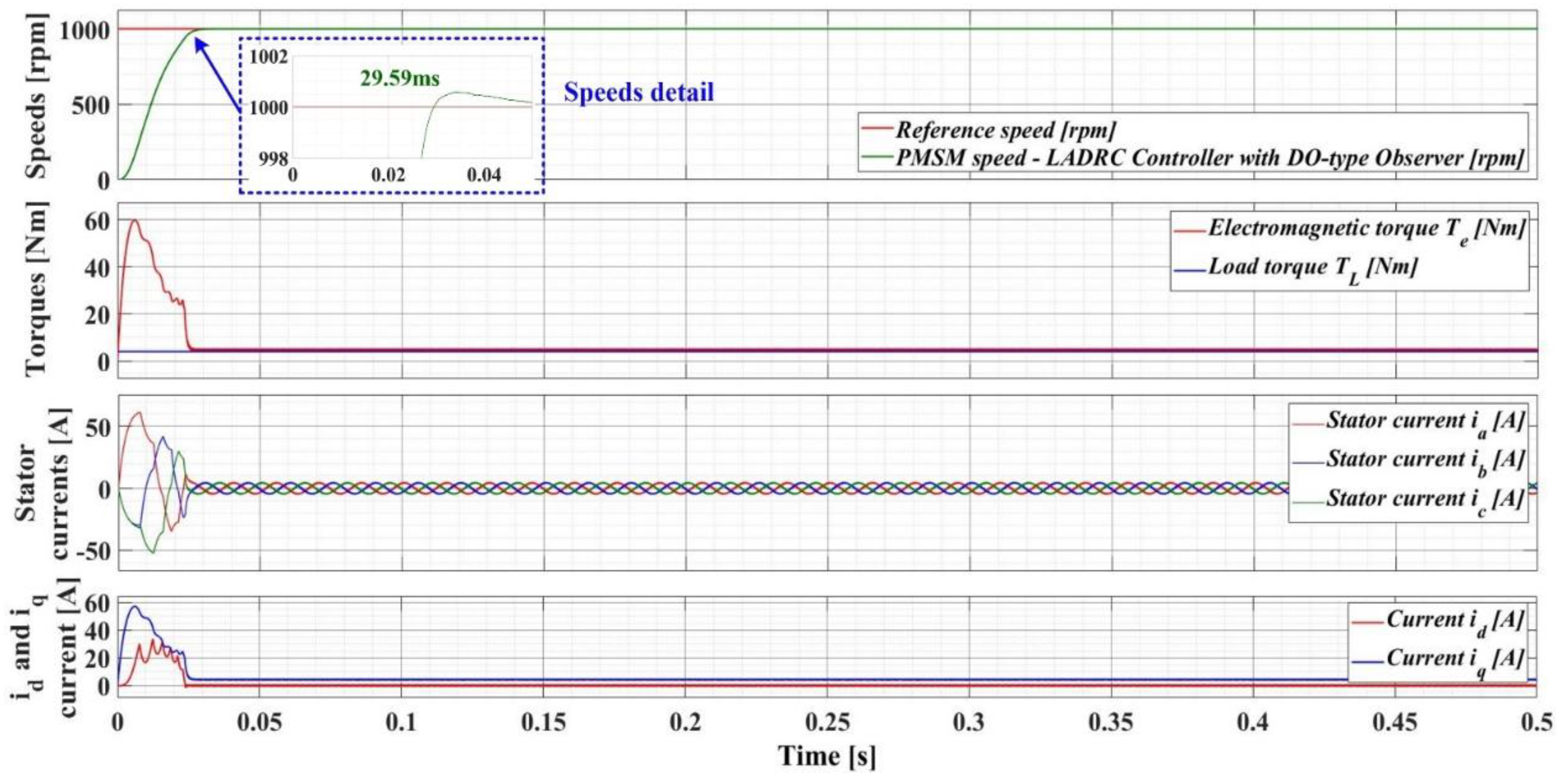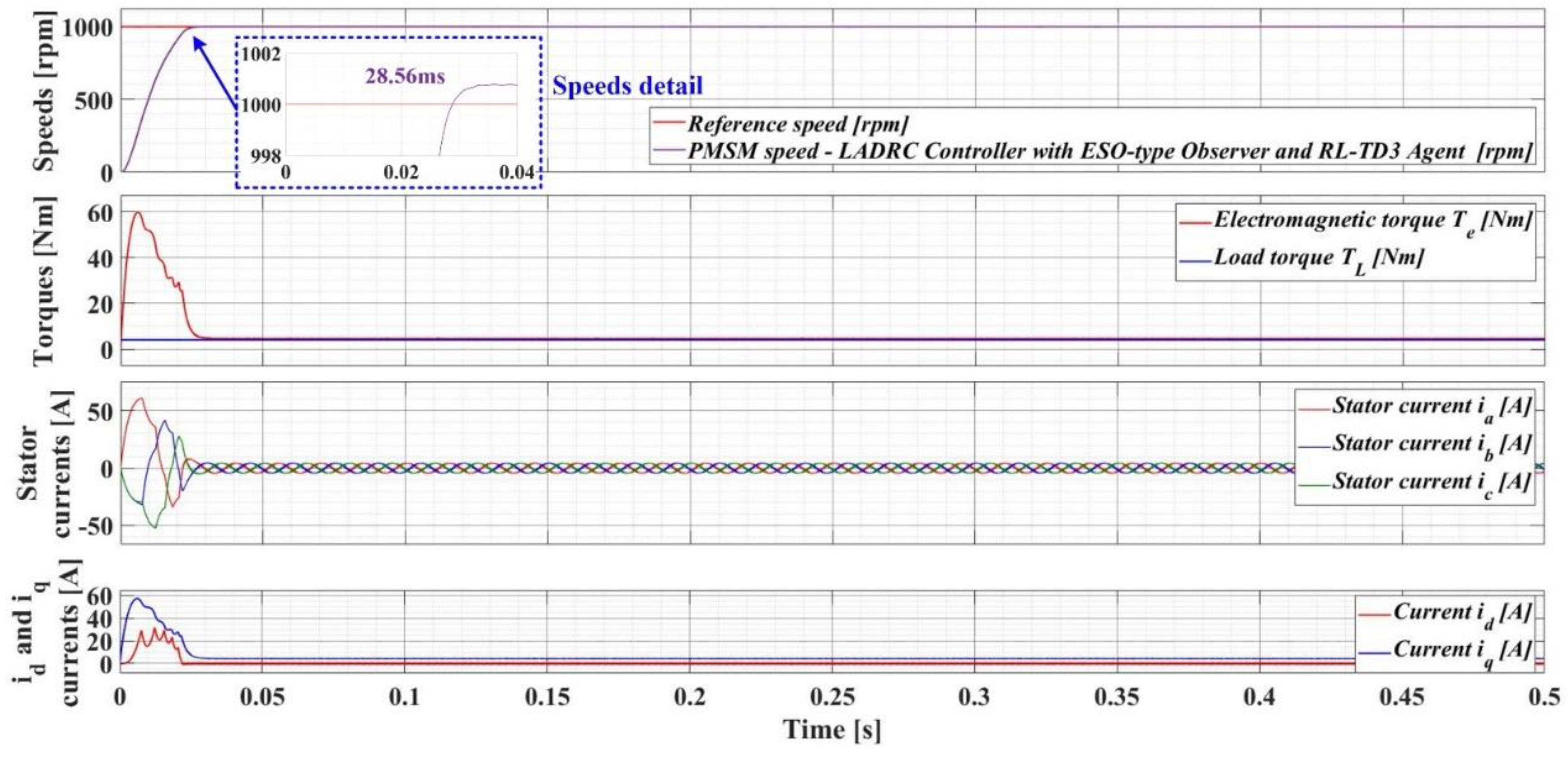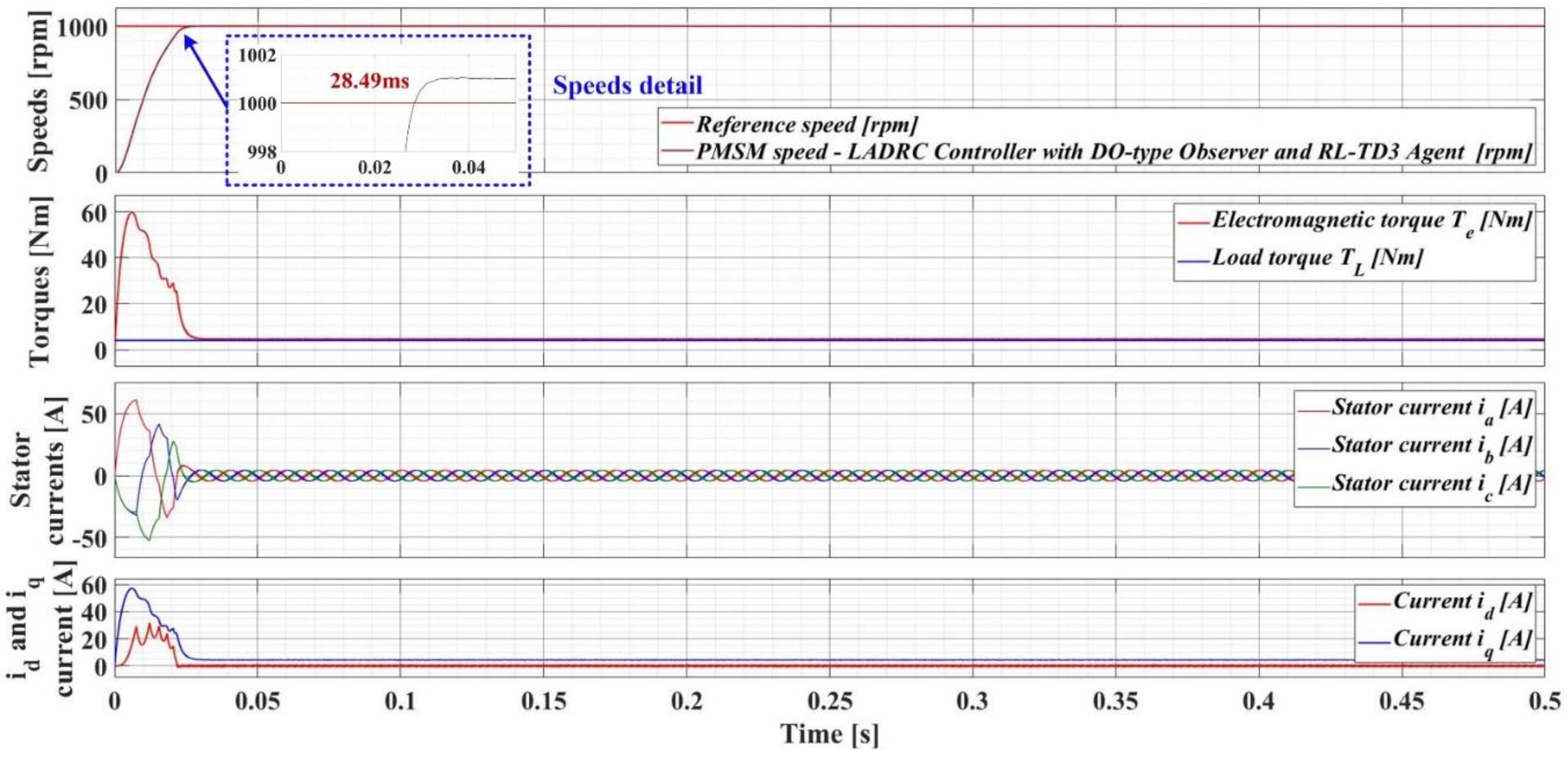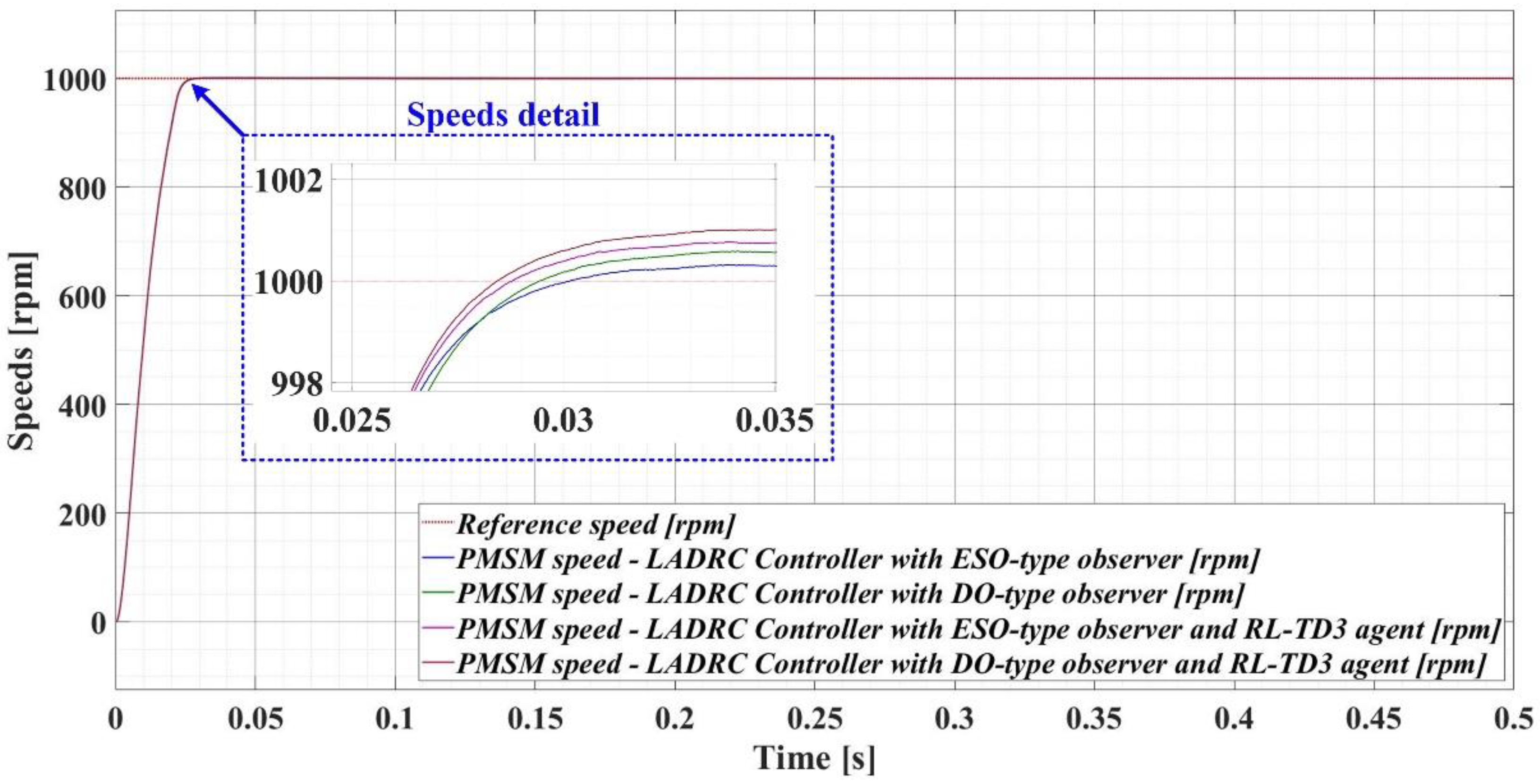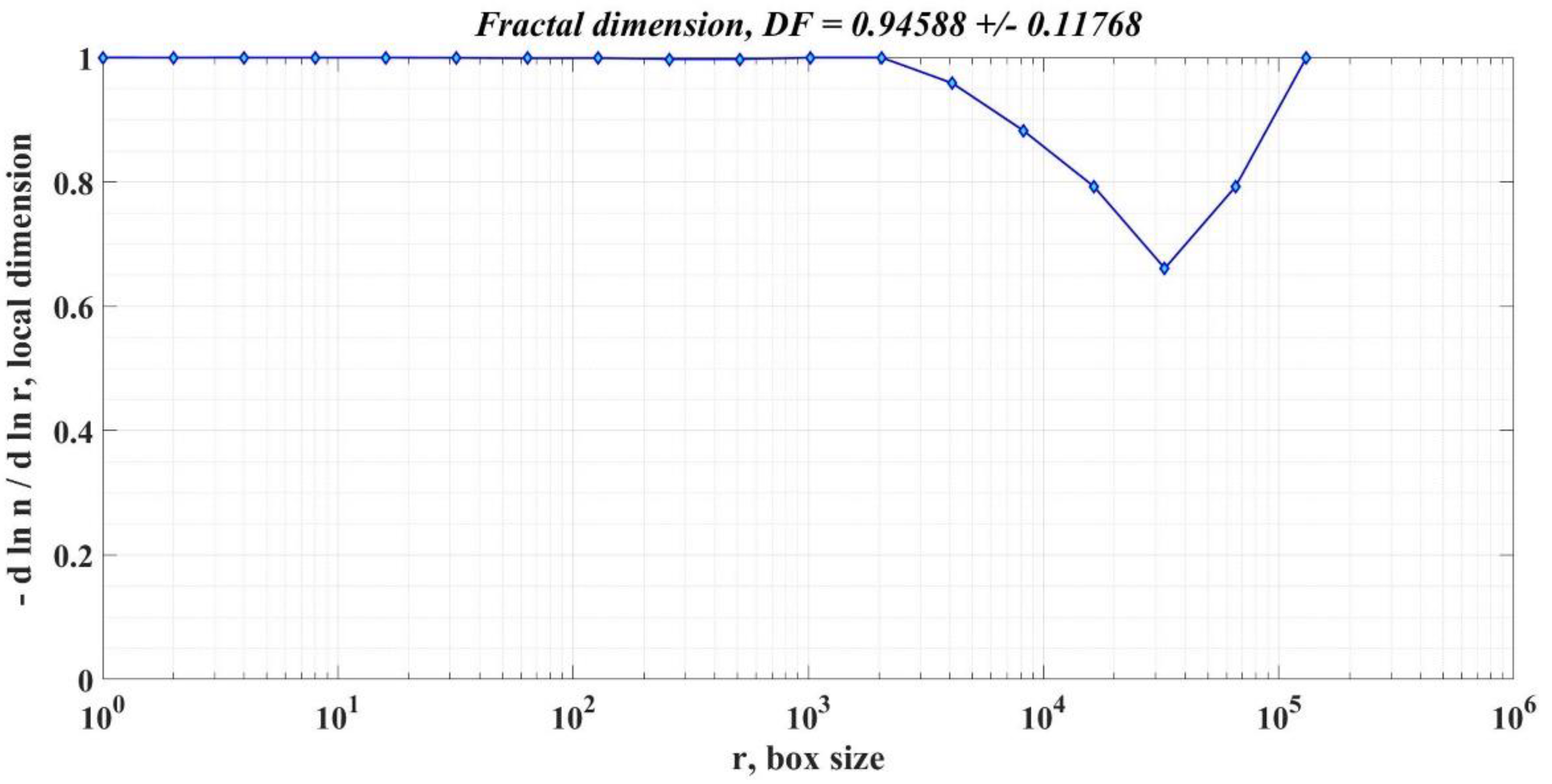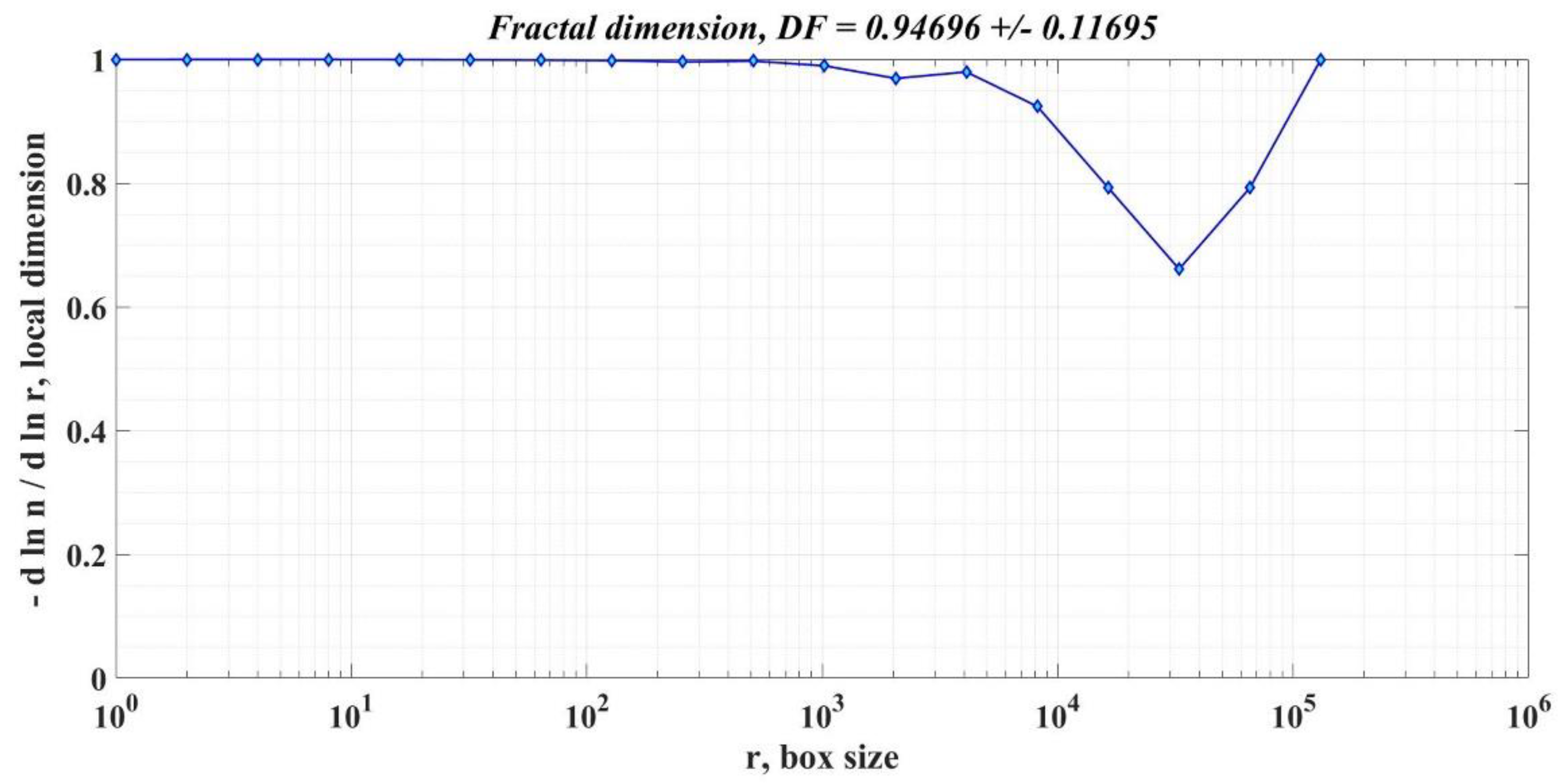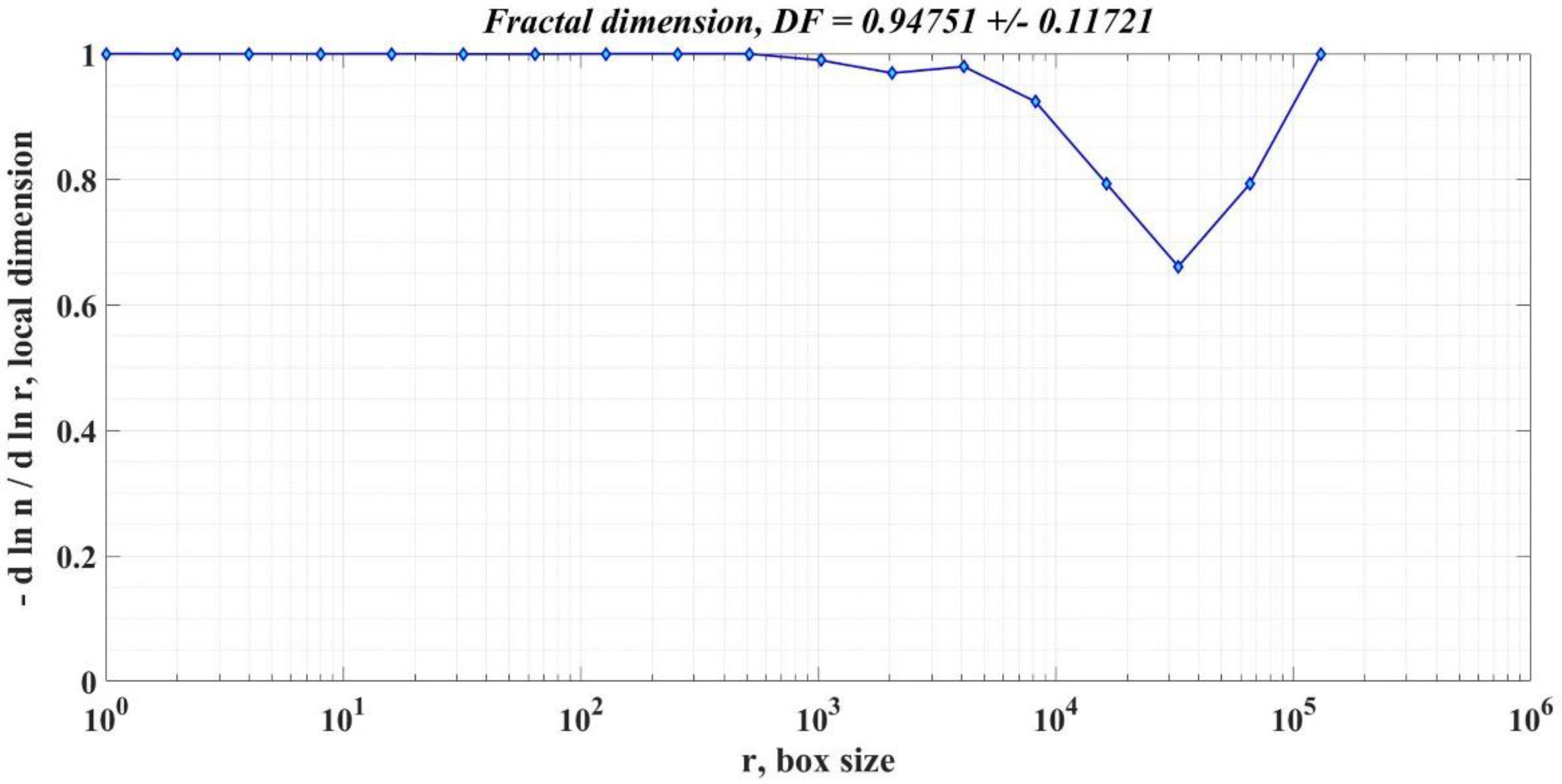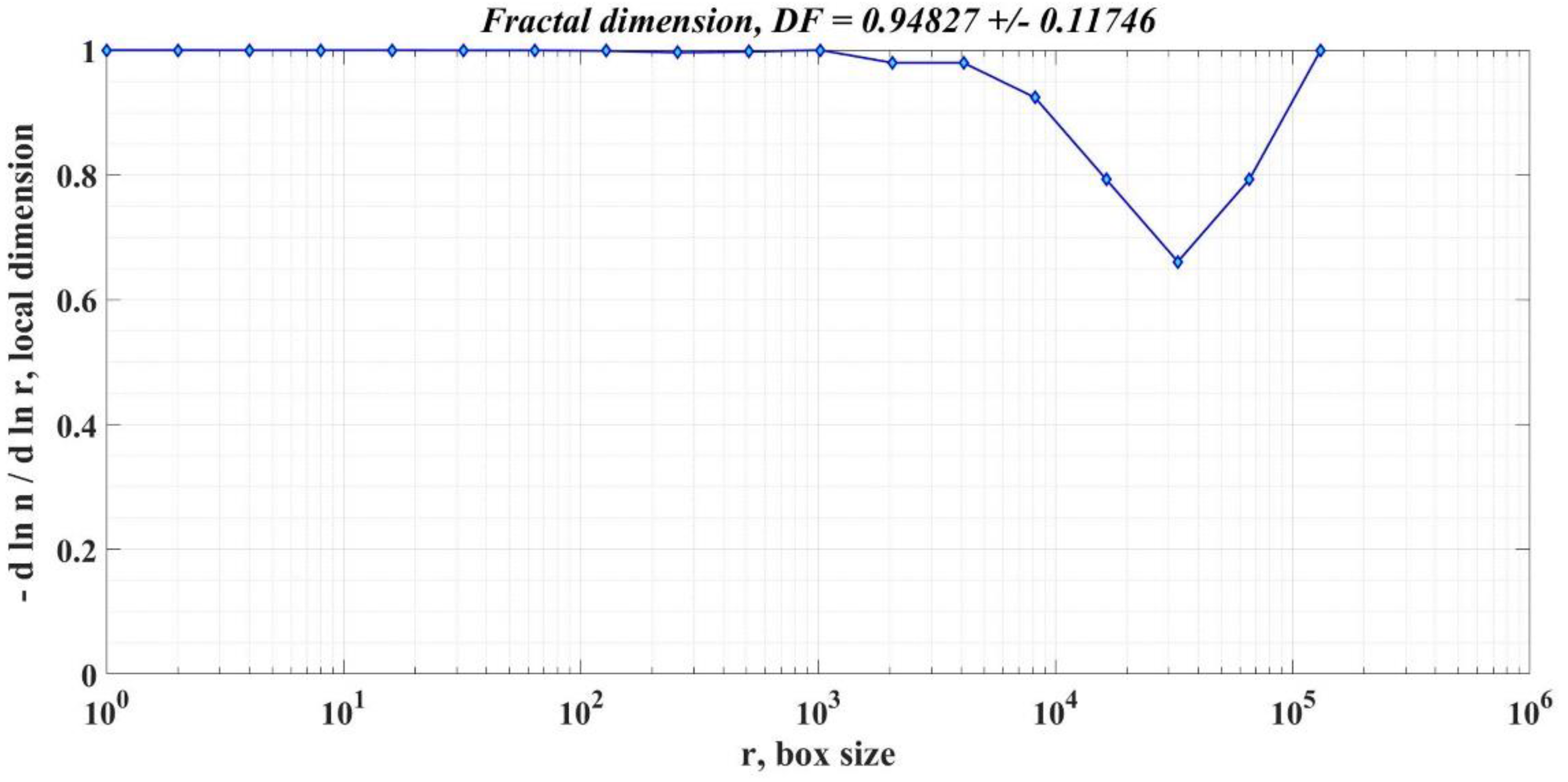1. Introduction
Typically, the overall control strategy of a PMSM is of the FOC type [
1,
2,
3], which includes two cascaded control loops, the inner loop providing current control and the outer loop providing PMSM rotor speed control. Due to the multitude of applications and domains, among which we can mention: robotics, computer peripherals, aerospace industry, electric drives [
4,
5], in which PMSM is used, the controllers implemented in the global FOC strategy have also evolved from simple to complex, i.e. from classical PI-type controllers [
6,
7] to adaptive [
8,
9], predictive [
10,
11] or robust [
11] type controllers [
12,
13].
Also, by using state estimators and in particular by estimating the PMSM rotor speed, sensorless control systems are obtained that have the advantage of providing high system reliability by eliminating additional hardware structures such as speed sensors. Common state estimators include Luenberger Observer [
14,
15], Model Reference Adaptive System (MRAS) [
16,
17], Sliding Mode Observer (SMO) [
18,
19], for the case where the deterministic approach is chosen, and for the case where the stochastic approach is chosen, estimators of the Kalman filter type are used [
20,
21].
In the case of PMSM rotor speed control, the load torque can be considered as a disturbance acting on the system, and in the case of using a suitable ESO-type observer [
22,
23,
24,
25], after a good estimation of the disturbance, the use of a LADRC-type controller [
26,
27,
28,
29] ensures the operation of the whole control system as equivalent to an ideal double integrator, which means an easy adjustment to obtain the desired performance of the control system. In this respect, the ESO-type observer synthesis is essential. In terms of estimating the disturbances acting on the system, this paper proposes the use of a DO-type observer [
30,
31,
32,
33]. It is also proposed to use an RL-TD3 agent [
34,
35,
36] which, after the training period, will provide correction signals to the ESO/DO type observer to estimate the external disturbances as accurately as possible. In this way, the LADRC controller used together with the proposed control structure will ensure superior performance of the PMSM control system. Typically, PI type controllers provide good performance in a linearized area and in case of large torque variations the response times increase and steady-state error occurs. The control structure proposed in this paper provides a good control performance in the case of load torque variation as well as in the case of parametric variation.
The operating equations and structures of the Matlab/Simulink implementation of the main blocks of the proposed control system based on LADRC, ESO/DO type observer together with RL-TD3 properly trained agent are presented.
The main contributions of this article are the follows:
Synthesis of a sensorless PMSM control system using a LADRC controller based on an ESO-type observer;
Synthesis of a sensorless PMSM control system using a LADRC controller based on a DO-type observer;
Optimization of the gain for DO-type observer using a computational intelligence ACO algorithm;
Utilizing the sensorless performance of the PMSM control system by using a LADRC controller based on an ESO/DO type observer in combination with an RL-TD3 agent, which provides correction signals to the ESO/DO type observer after the training period to achieve the most accurate estimation of disturbances and superior control performance;
Comparative presentation of the performance of the proposed sensorless control systems by comparing quality indicators such as response time, error, speed ripple and DF [
37,
38] of the PMSM rotor speed signal.
The rest of the article is organized as follows:
Section 2 presents the proposed sensorless control structure of PMSM. The LADRC control with ESO-type observer of PMSM este prezentat in
Section 3, while DO-type observer is presented in
Section 4. The Matlab/Simulink implementation of the improved control of PMSM based on LADRC with ESO-type observer/DO-type observer and RL-TD3 agent is presented in
Section 5, and the numerical simulation is presented in
Section 6. Section 7 presents some conclusions and suggestions for future approaches.
2. Sensorless Control of PMSM
The commonly used overall PMSM control strategy is based on a FOC structure with cascaded PI controllers performing current control in the inner loop and PMSM rotor speed control in the outer loop.
Figure 1 shows the block diagram of the FOC-type control structure for PMSM control system.
The notations used in relation (1) are the usual ones, and they describe the operation of the PMSM in the d-q rotating reference frame [
2,
3,
25]. Therefore, the following notations are used for the variables: the stator voltages and currents,
ud,
uq and
id,
iq; the stator inductances and resistances,
Ld,
Lq and
Rd,
Rq. Other parameters used in describing the PMSM operating equations are: the flux linkage (
λ0), the number of pole pairs (
np), the rotor moment inertia combined with load moment inertia (
J), the load torque (
TL), the viscous friction coefficient (
B), and the PMSM rotor speed (
ω).
The system shown in (1) can be rewritten in the form given in system (2) in the usual case where:
Ld =
Lq and
Rd =
Rq =
Rs [
2,
25]:
In the following sections, a LADRC controller with an ESO-type observer control structure is proposed. The replacement of the ESO-type observer with the DO-type observer is also proposed. Since the LADRC control is based on the estimation of the disturbance acting on the system with the help of an ESO-type observer, and after eliminating this term by the LADRC control law and achieving a double integrator behavior, it is proposed to use an RL-TD3 agent that, after the training period, will provide correction signals for a better estimation of the disturbance acting on the system. Thus,
Figure 2 shows the diagram of the proposed sensorless control system for PMSM based on LADRC controller with ESO-type observer and RL-TD3 agent. Similarly,
Figure 3 shows the diagram for the proposed PMSM sensorless control system based on LADRC controller with DO-type observer and RL-TD3 agent.
3. LADRC-type Control for PMSM
LADRC controllers can be used to control a PMSM where the load torque TL (considered as an external disturbance) may have significant amplitude variations. For this purpose, a state observer of the ESO type is used to estimate both the speed of the PMSM rotor and the external disturbance. In this way, the command provided by the LADRC controller will cancel the effect of external disturbances and give the control system behavior equivalent to an integrator-type system, thus achieving superior PMSM control performance. It is concluded that the main problem in this section is the synthesis of an ESO-type observer that provides the most accurate PMSM rotor speed and external disturbance.
In the general case, we can start from a differential equation of order n, given by a relation of the form (3) [
25,
30].
Thus, equation (3) describes a monovariable nonlinear system affected by perturbations. Let l be the derivative of the system output y by y(l),, the system input is u u, and the disturbance acting on the system is denoted by d.
After using the notations:
,
, we can rewrite the system given in relation (3) as the following system:
An additional state is added in the form of the system (5).
The form of the function h(t) can be obtained from system (5) as follows:
The disturbances acting on the system are included in the variable f.
Starting from these elements the synthesis of an ESO-type observer can be written as follows [
25,
30]:
The ESO-type observer system described by relation (7) will provide an estimate of the initial system states, plus an estimate of the f-term incorporating the perturbations.
Adapting the above relations to a second-order system yields relation (8), where the system input is u, the system output is y, the external disturbance is w, and b is considered a tuning parameter in the LADRC controller structure [
26,
29].
In relation (8), the notations are as follows: , , and . f denotes an extended state of the system that includes disturbances acting on the system and parametric uncertainties.
An ESO-type observer can be described by the following system:
In system (9), the difference between the actual and estimated output of the system is denoted by e, and zi denotes the estimates of the states. In addition, Li denotes the gain factors (amplifications) of the observer.
Define the nonlinear function
fal(
e,
α,
δ), which is defined by relation (10), where
, and the nonlinearity of the function is characterized by a small number
δ.
From this, the LADRC controller provides the control input u given by the following equations:
where:
Kp and
Kd represents the tuning parameters of the LADRC controller, and the reference is denoted by r (in the case of PMSM equations of motion –
ωref).
By linearizing equations (10) and (11), the linear forms given by relations (12) and (13) are obtained, and a graphical description of the LADRC control structure of a PMSM is given in
Figure 4. The ESO-type observer (third order) block diagram for rotor speed PMSM estimation is shown in
Figure 5.
Assuming in relation (8)
, where f has a bounded increase, we obtain the equivalent linear system in the form given in (14).
where:
,
,
, and
.
In the case of a second-order system, an ESO-type observer of order 3 is obtained, which can be described by the system (15).
In system (15), the vector of gain factors is given by:
The frequency band of the ESO-type observer is denoted by
ω0. The poles of the ESO-type observer are assigned to -
ω0, and thus from relation (17) we obtain the vector L from relation (16) in the form of relation (18).
In relation (19), the u command represents the output of the LADRC controller.
The signal
u0 is a control signal provided by the ideal dynamic system of type (20) and (21), in which an exact rejection of disturbances
z3 =
f occurs.
Thus, the behavior of the PMSM control system in which the controller is LADRC-type and the external disturbance-type signal is estimated using an ESO-type observer is equivalent to an ideal system (20) and (21). Note that equation (21) is of an ideal double integrator, and the command signal
u0 can be chosen in the following form:
Note that the u0 command signal is equivalent to the signal provided by a PD (proportional derivative) type controller.
The frequency band of the LADRC controller is denoted by
ωc. The poles of this controller are assigned to -
ωc in relationship (23).
From the description of the PMSM equations in section 2, it can be seen that they can be reduced to a differential equation of order 1, described by the relation (26).
In relation (26), the generalized disturbance f can be written in the form given in relation (27).
By replacing relation (27) in relation (26), the following expression is obtained:
It is noted
,
, and
. Based on this, the PMSM system can be described as a 2nd order system:
where:
,
,
, and
.
One can synthesize an ESO-type observer of order 2 as in Eqs. (30) and (31), where the PMSM rotor speed estimate is given by z1, and the generalized disturbance estimate f is given by z2.
In relation (31), the vector of gain factors is obtained by assigning the poles to –
ω0 by identifying the coefficients of a second-order polynomial as follows:
Based on the above, the control law is given in the following form:
The equivalent dynamical system in the form of an integrator is given by the relation (33).
It can be seen that the control law u0 is given by relation (34) in the form of a proportional controller.
In relation (34), r is the PMSM rotor speed reference,
Kp =
ωc2, and a graphical description of the LADRC control structure of a PMSM is shown in
Figure 6. The ESO-type observer (second order) block diagram for rotor speed PMSM estimation is shown in
Figure 7.
4. DO-type Observer
Let us consider the nonlinear system in the relation (35):
where:
is the state,
is the control input,
is the output vector, and disturbance
.
Given that
f(
x),
g1(
x),
g2(
x), and
h(
x) are smooth functions in x, the challenge is to implement an observer to estimate the disturbance in the system. (35). According to [
30], the observer structure is defined in the relation (26).
where:
is the state of the nonlinear observer,
g(
x) is a function to be designed.
l(
x) denotes the observer's gain when expressed by the relation (37).
Given
, it is shown in [
30] that the observer described in relation (36) reconstructs the asymptotic perturbation d under the condition that the gain l(x) is chosen such that equation (38) is asymptotically stable.
Starting from the PMSM equations described in section 2, they can be rewritten in the d-q reference frame as in relations (39) and (40). Note that the notations are the usual ones, but when writing relation (39), the terms containing the external perturbation are highlighted.
where:
In relation (40), parametric variations can be considered, resulting in relations (41) and (42).
where:
k1n,
k2n,
k3n represent the nominal parameters and the parametric variations are denoted by Δ
k1, Δ
k2, Δ
k3.
The term that includes disturbances caused by parametric variations is denoted by d.
Assuming that these parametric variations have bounded values, an observer of the type given in relation (36), but in a linearized form can be defined as in relation (43).
In relation (43), as in the general nonlinear version,
is the estimate of d and p is the observer state. Let l be the gain of the observer, which is considered constant with respect to the general form given in relation (37), and let x be the state of the initial system.
Figure 9 shows the DO-type observer block diagram.
The estimation error is assumed to be bounded according to the relation (44).
The expressions in relation (45) are obtained by calculating the derivative of the estimation error in relation (44).
In relation (45),
is calculated from relation (42) taking into account expressions (39), (40), and (41). Based on this, we obtain the following relationship:
From relation (46) we can conclude that the observer proposed in relation (43) is asymptotically stable for l > 0.
In particular, by using a DO-type observer and choosing Δ
k1 and Δ
k2 equal to zero, a simplified equation can be obtained as in relation (47), from which the load torque TL can be estimated.
The state vector is selected, where
,
, perturbation
and
equation (47) can be written in the following form:
Pentru a estima cuplul de sarcină
TL, se utilizează observerul descris în (49).
Figure 10 shows the DO-type observer block diagram for rotor speed PMSM estimation. The estimated quantities are the rotor position
θ, the rotor speed
ω, and the d term, which includes the uncertainties resulting from the parametric variation in the relationship (42).
Note that in
Figure 10, given the estimated
d-term (
), by adding the term
, we can obtain exactly the term denoted by
z3, which represents the generalized perturbation denoted by f in relation (27), which characterizes the ESO-type observer. Considering this specification,
Figure 11 proposes the block diagram of the LADRC-type PMSM speed control using the DO-type observer, where the estimated quantities
z1,
z2, and
z3 are estimated using the DO-type observer instead of the ESO-type observer.
5. Matlab/Simulink Implementation of Improved Control of PMSM based on LADRC with ESO-type observer/DO-type observer and RL-TD3 Agent
The Matlab/Simulink implementations in this section are based on the description in the previous sections, and the nominal parameters of the PMSM used are shown in
Table 1.
Figure 12 shows the block diagram of the Matlab/Simulink implementation for PMSM control based on LADRC controller and ESO-type observer.
To improve the performance of the LADRC-type controller based on an ESO-type observer for disturbance estimation as shown in system (15), an RL-TD3 agent can be used (
Figure 13).
The implementation of an RL-TD3 agent first requires a training phase, during which the RL-TD3 agent, based on the signals collected from the system and by maximizing a reward that can be considered as an integral performance criterion, will provide a correction signal for the current reference
iqref. Next, the inner current control loops are those used in the FOC control strategy and can be implemented as ON/OFF controllers with hysteresis for fast response. The usual expression of reward is given in relation (50). The first four terms refer to the actual error due to the
d-
q reference frame terms,
id and
iq currents, and the speed and position of the PMSM rotor
ω and
θ relative to their references. The last term
in the relation (50) contains the actions that were generated at the previous times.
Figure 14 shows the evolution of the performance for the RL-TD3-type agent for improvement of LADRC with ESO-type observer for PMSM control.
For the implementation of the proposal presented at the end of
Section 4, where the ESO-type observer is replaced by a DO-type observer described by the system (49),
Figure 15 shows the block diagram of the Matlab/Simulink implementation for PMSM control based on LADRC controller and DO-type observer.
Similar to the way presented for the LADRC controller improvement using an RL-TD3 agent when using an ESO-type observer, a similar structure as shown in
Figure 16 can be used when using a DO-type observer. By using the same strategies and reward given by relation (50) in case of using LADRC based on ESO-type observer, in case of using DO-type observer,
Figure 16 shows the block diagram of the Matlab/Simulink implementation for PMSM control based on LADRC controller and DO-type observer using RL-TD3 agent. Furthermore,
Figure 17 shows the evolution of the performance for the RL-TD3 type agent for the improvement of LADRC with DO type observer for PMSM control.
To optimize the value of the parameter
l in system (49), which represents the gain of the DO-type observer, a computational intelligence algorithm, namely ACO [
37], is used.
Figure 18 shows the performance of the ACO-type algorithm for optimization of the DO-type observer gain. After optimization the obtained value of parameter
l is 191.
6. Numerical Simulations
This section presents numerical simulations for a PMSM whose parameters are presented in section 5, and the controllers used are of type PI and LADRC, respectively, as presented in the previous sections. The PI type controller ensures a good performance of the PMSM rotor speed control system when the load torque is close to the nominal value. Therefore,
Figure 19 shows the evolution of the PMSM rotor speed, electromagnetic torque, stator currents, and id and iq currents in the d-q reference frame. The PMSM rotor speed reference sequence is as follows:
ωref = [1000 1200 1400 900]rpm for a load torque
TL = 0.5Nm.
Figure 19 (a) shows the evolution of the parameters of PMSM control system based on PI speed controller,
Figure 19 (b) shows the evolution of the parameters of PMSM control system based on LADRC controller with ESO-type observer, and
Figure 19 (c) shows the comparison between the performance of PMSM control system based on classical type PI controller and LADRC controller with ESO-type observer. It can be seen that the difference in performance between the two control systems is minimal. The numerical values of the main parameters of the LADRC controller based on an ESO-type observer are
ωc = 100rad/s,
ω0 = 200rad/s, and
b = 1325.
By increasing the load torque TL to 2Nm, it can be seen in
Figure 20 that the PMSM control system based on the classical PI controller manages to stabilize the system, but with a steady-state error and a longer response time compared to the case where the load torque is greater than 0.5Nm. However, it can be seen that the control performance remains the same when using the LADRC controller with an ESO-type observer.
Figure 21 shows the time evolution of the PMSM control system parameters using the LADRC controller with an ESO-type observer for a speed reference
ωref = 1000 rpm and a load torque
TL = 4Nm. It is observed that the PMSM control system based on LADRC controller with ESO-type observer achieves a very good control performance even though the load torque has increased greatly. The explanation, as presented in section 3, is that by estimating the load torque as accurately as possible, the control system compensates for the effect of this variable, which can be considered as a disturbance, and the overall behavior of the control system approaches that of a linear type, which maintains its performance even over a wide range of parameter variations. For example, in
Figure 22, the performance of the control system is maintained for a 100% variation of J parameter and TL = 4Nm with uniform distributed noise.
As shown in
Section 4, the estimation of the load torque, considered as a disturbance parameter, can also be performed with a DO-type observer integrated in the LADRC structure, and the results of the PMSM control system are also very good, similar to those obtained when using an ESO-type observer.
Using the diagrams proposed in the previous sections for the use of an RL-TD3 agent to improve the performance of the PMSM rotor speed control system,
Figure 24 and
Figure 25 show the response of the PMSM control system based on the LADRC controller with embedded ESO-type observer (
Figure 24) and DO-type observer (
Figure 25).
Figure 26 shows the comparative evolution of the PMSM speed under the conditions where the controller used for the PMSM control system is one of the following: LADRC controller with ESO-type observer, LADRC controller with DO-type observer, LADRC controller with ESO-type observer and RL-TD3 agent, and LADRC controller with DO-type observer and RL-TD3 agent. It can be seen that the LADRC controller with DO observer and RL-TD3 agent has the best performance in terms of PMSM rotor speed control.
To compare the performance of the proposed control systems, the DF calculation was also taken into account. It can be specified that the box-counting method is used to calculate DF according to [
38,
39]. Thus,
Figure 27,
Figure 28,
Figure 29 and
Figure 30 show the graphical representation for DF of the PMSM rotor speed signal for each of the proposed control systems based on combinations of the LADRC controller with ESO/DO type observer and RL-TD3 agent. Again, when using PMSM rotor speed control systems, it can be seen that the higher the performance of the control system, the higher the DF of the PMSM rotor speed signal, as shown in
Table 2.
While the first part of this section demonstrated the superiority of the LADRC controller over the classical PI controller through numerical simulations,
Table 2 summarizes the comparative performance of the LADRC controller based on the ESO-type observer and the DO-type observer. Similar performance is observed with a slight superiority when using the DO type observer. An increase in the performance of the LADRC controller based on the ESO/DO type observer is achieved by using an RL-TD3 agent.
Table 2 shows the performance improvements when using an RL-TD3 agent due to the 1ms reduction in response time, but also due to the reduction in rotor speed ripple. The following quality indicators are used to compare the performance of the control systems presented: response time, rotor speed ripple, and DF of PMSM rotor speed signal. It can be concluded that the use of an RL-TD3 agent improves the performance of the LADRC controller in that the RL-TD3 agent will provide correction signals that ensure a more accurate estimation of the disturbance acting on the system, the LADRC controller will still ensure a global behavior like that of a double integrator by using a PD control law.
Figure 1.
FOC strategy block diagram for PMSM control system using PI classical controllers.
Figure 1.
FOC strategy block diagram for PMSM control system using PI classical controllers.
Figure 2.
Proposed PMSM control system using LADRC controller and ESO-type observer using RL-TD3 agent.
Figure 2.
Proposed PMSM control system using LADRC controller and ESO-type observer using RL-TD3 agent.
Figure 3.
Proposed PMSM control system using LADRC controller and DO-type observer using RL-TD3 agent.
Figure 3.
Proposed PMSM control system using LADRC controller and DO-type observer using RL-TD3 agent.
Figure 4.
LADRC-type control using ESO-type observer (third order) block diagram.
Figure 4.
LADRC-type control using ESO-type observer (third order) block diagram.
Figure 5.
ESO-type observer (third order) block diagram for rotor speed PMSM estimation.
Figure 5.
ESO-type observer (third order) block diagram for rotor speed PMSM estimation.
Figure 6.
LADRC-type PMSM speed control using ESO-type observer (second order) block diagram.
Figure 6.
LADRC-type PMSM speed control using ESO-type observer (second order) block diagram.
Figure 7.
ESO-type observer (second order) block diagram for rotor speed PMSM estimation.
Figure 7.
ESO-type observer (second order) block diagram for rotor speed PMSM estimation.
Figure 9.
DO-type observer block diagram.
Figure 9.
DO-type observer block diagram.
Figure 10.
DO-type observer block diagram for rotor speed PMSM estimation.
Figure 10.
DO-type observer block diagram for rotor speed PMSM estimation.
Figure 11.
LADRC-type PMSM speed control using DO-type observer block diagram.
Figure 11.
LADRC-type PMSM speed control using DO-type observer block diagram.
Figure 12.
Matlab/Simulink block diagram implementation for PMSM control based on LADRC controller and ESO-type observer.
Figure 12.
Matlab/Simulink block diagram implementation for PMSM control based on LADRC controller and ESO-type observer.
Figure 13.
Matlab/Simulink block diagram implementation for PMSM control based on LADRC controller and ESO-type observer using RL-TD3 agent.
Figure 13.
Matlab/Simulink block diagram implementation for PMSM control based on LADRC controller and ESO-type observer using RL-TD3 agent.
Figure 14.
Evolution of the performance for the RL-TD3-type agent for improvement of LADRC with ESO-type observer for PMSM control.
Figure 14.
Evolution of the performance for the RL-TD3-type agent for improvement of LADRC with ESO-type observer for PMSM control.
Figure 15.
Block diagram of Matlab/Simulink implementation for PMSM control based on LADRC controller and DO-type observer.
Figure 15.
Block diagram of Matlab/Simulink implementation for PMSM control based on LADRC controller and DO-type observer.
Figure 16.
Matlab/Simulink block diagram implementation for PMSM control based on LADRC controller and DO-type observer using RL-TD3 agent.
Figure 16.
Matlab/Simulink block diagram implementation for PMSM control based on LADRC controller and DO-type observer using RL-TD3 agent.
Figure 17.
Evolution of the performance for the RL-TD3-type agent for the improvement of LADRC with DO-type observer for PMSM control.
Figure 17.
Evolution of the performance for the RL-TD3-type agent for the improvement of LADRC with DO-type observer for PMSM control.
Figure 18.
Performance of the ACO-type algorithm for optimization of the DO-type observer gain.
Figure 18.
Performance of the ACO-type algorithm for optimization of the DO-type observer gain.
Figure 19.
PMSM control system based on PI speed controller versus PMSM control system based on LADRC controller with ESO-type observer (ωref = [1000 1200 1400 900]rpm and TL = 0.5Nm): (a) Parameters evolution of PMSM control system based on PI speed controller; (b) Parameters evolution of PMSM control system based on LADRC controller with ESO-type observer; (c) Speeds time evolution comparison for PI versus LADRC with ESO-type observer controllers of PMSM control system.
Figure 19.
PMSM control system based on PI speed controller versus PMSM control system based on LADRC controller with ESO-type observer (ωref = [1000 1200 1400 900]rpm and TL = 0.5Nm): (a) Parameters evolution of PMSM control system based on PI speed controller; (b) Parameters evolution of PMSM control system based on LADRC controller with ESO-type observer; (c) Speeds time evolution comparison for PI versus LADRC with ESO-type observer controllers of PMSM control system.
Figure 20.
Speeds time evolution comparison for PI versus LADRC with ESO-type observer controllers of PMSM control system (ωref = [1000 1200 1400 900]rpm and TL = 2Nm).
Figure 20.
Speeds time evolution comparison for PI versus LADRC with ESO-type observer controllers of PMSM control system (ωref = [1000 1200 1400 900]rpm and TL = 2Nm).
Figure 21.
Time evolution of PMSM control system parameters using LADRC controller with ESO-type observer (ωref = 1000rpm and TL = 4Nm).
Figure 21.
Time evolution of PMSM control system parameters using LADRC controller with ESO-type observer (ωref = 1000rpm and TL = 4Nm).
Figure 22.
Time evolution of PMSM control system parameters using LADRC controller with ESO-type observer (ωref = 1000rpm, TL = 4Nm with uniform distributed noise, and an increase of 100% for J parameter).
Figure 22.
Time evolution of PMSM control system parameters using LADRC controller with ESO-type observer (ωref = 1000rpm, TL = 4Nm with uniform distributed noise, and an increase of 100% for J parameter).
Figure 23.
Time evolution of PMSM control system parameters using LADRC controller with DO-type observer (ωref = 1000rpm and TL = 4Nm).
Figure 23.
Time evolution of PMSM control system parameters using LADRC controller with DO-type observer (ωref = 1000rpm and TL = 4Nm).
Figure 24.
Time evolution of PMSM control system parameters using LADRC controller with ESO-type observer and RL-TD3 agent (ωref = 1000rpm and TL = 4Nm).
Figure 24.
Time evolution of PMSM control system parameters using LADRC controller with ESO-type observer and RL-TD3 agent (ωref = 1000rpm and TL = 4Nm).
Figure 25.
Time evolution of PMSM control system parameters using LADRC controller with DO-type observer and RL-TD3 agent (ωref = 1000rpm and TL = 4Nm).
Figure 25.
Time evolution of PMSM control system parameters using LADRC controller with DO-type observer and RL-TD3 agent (ωref = 1000rpm and TL = 4Nm).
Figure 26.
Speeds evolution comparison for proposed control systems for PMSM based on LADRC controller with ESO/DO type observer and RL-TD3 agent.
Figure 26.
Speeds evolution comparison for proposed control systems for PMSM based on LADRC controller with ESO/DO type observer and RL-TD3 agent.
Figure 27.
Graphical representation for DF of speed signal – PMSM control system based on LADRC controller with ESO-type observer.
Figure 27.
Graphical representation for DF of speed signal – PMSM control system based on LADRC controller with ESO-type observer.
Figure 28.
Graphical representation for DF of speed signal – PMSM control system based on LADRC controller with DO-type observer.
Figure 28.
Graphical representation for DF of speed signal – PMSM control system based on LADRC controller with DO-type observer.
Figure 29.
Graphical representation for DF of speed signal – PMSM control system based on LADRC controller with ESO-type observer and RL-TD3 agent.
Figure 29.
Graphical representation for DF of speed signal – PMSM control system based on LADRC controller with ESO-type observer and RL-TD3 agent.
Figure 30.
Graphical representation for DF of speed signal – PMSM control system based on LADRC controller with DO-type observer and RL-TD3 agent.
Figure 30.
Graphical representation for DF of speed signal – PMSM control system based on LADRC controller with DO-type observer and RL-TD3 agent.
Table 1.
PMSM nominal parameters used in numerical simulation.
Table 1.
PMSM nominal parameters used in numerical simulation.
| Parameter |
Value |
Unit |
| Stator resistance - Rs
|
2.875 |
Ω |
| Inductances on d-q rotating reference frame – Ld and Lq
|
0.0085 |
H |
| Combined inertia of rotor and load - J
|
0.008 |
kg·m2
|
| Combined viscous friction of rotor and load - B
|
0.005 |
N·m·s/rad |
| Flux induced by the permanent magnets of the rotor in the stator phases - λ0
|
0.175 |
Wb |
| PMSM Pole pairs number - nP
|
4 |
- |
Table 2.
Performances of proposed controllers for PMSM sensored control system.
Table 2.
Performances of proposed controllers for PMSM sensored control system.
| Controller type for PMSM speed control |
Response time
[ms] |
Rotor speed ripple
[rpm] |
DF of PMSM rotor speed signal |
| LADRC Controller with ESO-type Observer |
30.19 |
119.79 |
0.94588 +/– 0.11768 |
| LADRC Controller with DO-type Observer |
29.59 |
118.56 |
0.94696 +/– 0.16951 |
| LADRC Controller with ESO-type Observer and RL-TD3 Agent |
28.56 |
117.42 |
0.94751 +/– 0.11721 |
| LADRC Controller with DO-type Observer and RL-TD3 Agent |
28.49 |
116.38 |
0.94827 +/– 0.11746 |



